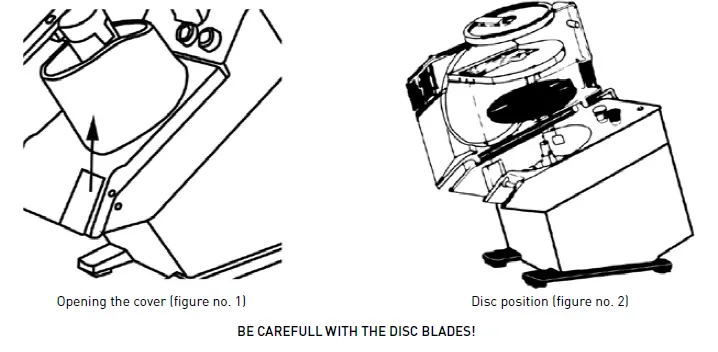
HENDI Salamander 264607. 264706
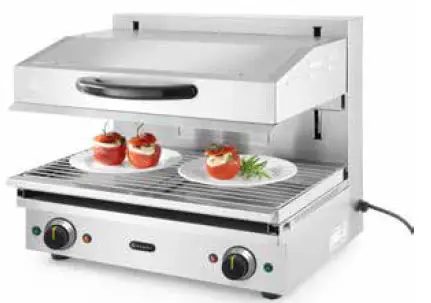
You should read this user manual carefully before using the appliance. Keep these instructions with the appliance. For indoor use only.
Dear Customer,
Thank you for purchasing this Hendi appliance. Before using the appliance for the first time, please read this manual carefully, paying particular attention to the safety regulations outlined below.
Safety regulations
- This appliance is intended for commercial use.
- The appliance must only be used for the purpose for which it was intended and designed. The manufacturer is not liable for any damage caused by incorrect operation and improper use.
- Keep the appliance and electrical plug away from water and any other liquids. In the event that the appliance should fall into water, immediately remove plug from the socket and do not use until the appliance has been checked by a certified technician. Failure to follow these instructions could cause a risk to lives.
- Never attempt to open the casing of the appliance yourself.
- Do not insert any objects in the casing of the appliance.
- Do not touch the plug with wet or damp hands.
- Danger of electric shock! Do not attempt to repair the appliance yourself. In case of malfunctions, repairs are to be conducted by qualified personnel only.
- Never use a damaged appliance! Disconnect the appliance from the electrical outlet and contact the retailer if it is damaged.
- Warning! Do not immerse the electrical parts of the appliance in water or other liquids. Never hold the appliance under running water.
- Regularly check the power plug and cord for any damage. If the power plug or power cord is damaged, it must be replaced by a service agent or similarly qualified persons in order to avoid danger or injury.
- Make sure the cord does not come in contact with sharp or hot objects and keep it away from open fire. To pull the plug out of the socket, always pull on the plug and not on the cord.
- Ensure that the cord (or extension cord) is positioned so that it will not cause a trip hazard.
- Always keep an eye on the appliance when in use.
- Warning! As long as the plug is in the socket the appliance is connected to the power source.
- Turn off the appliance before pulling the plug out of the socket.
- Never carry the appliance by the cord.
- Do not use any extra devices that are not supplied along with the appliance.
- Only connect the appliance to an electrical outlet with the voltage and frequency mentioned on the appliance label.
- Connect the power plug to an easily accessible electrical outlet so that in case of emergency the appliance can be unplugged immediately. To completely switch off the appliance pull the power plug out of the electrical outlet.
- Always turn the appliance off before disconnecting the plug.
- Never use accessories other than those recommended by the manufacturer. Failure to do so could pose a safety risk to the user and could damage the appliance. Only use original parts and accessories.
- This appliance is not intended for use by persons (including children) with reduced physical, sensory or mental capabilities, or lack of experience and knowledge.
- This appliance must not be used by children under any circumstances.
- Keep the appliance and its cord out of reach of children.
- Always disconnect the appliance from the mains if it is left unattended or is not in use, and before assembly, disassembly or cleaning.
- Never leave the appliance unattended during use.
Special Safety Precautions
- Hot surface! Risks of burns! The grid and the adjacent metal enclosure part becomes very hot during operation. Therefore, touch only the designated handle and the rotating knob only.
- The utensil (not supplied) that put on the grid should be heat resistant.
- Do not cover the appliance during operation and keep it away from inflammable objects, e. g. curtains, newspaper or liquid such as alcohol & fuels
- Do not place the appliance near heat sources, like cooking stove, heater or fire.
- This appliance is only served for the preparation of food.
- Use the appliance only in a well-ventilated area. Place the appliance on a flat, horizontal, stable surface. Leave at least 20 cm spacings from surrounding for ventilation purpose.
- Clean the appliance after each use to avoid infestation with mould fungus or vermin.
- The grid and the dripping tray are not dishwasher safe and must be cleaned by hands.
- Allow completely cool down before storage and cleaning.
- Warning! During installation, do not place on surfaces or near walls, partitions, or kitchen furniture and the like — unless they are made of non-combustible material or clad with a suitable non-combustible heat insulating material, and also pay attention to the fire prevention regulations.
Intended use
- This appliance is intended for professional use.
- This appliance is designed only for grilling appropriate food products. Any other use may lead to damage of the appliance or personal injury.
- Operating the appliance for any other purpose shall be deemed a misuse of the device. The user shall be solely liable for improper use of the device.
Grounding Installation
This is a class I appliance. This appliance must be grounded. In the event of an electrical short circuit, grounding reduces the risk of electric shock by providing an escape wire for the electric current. This appliance is equipped with a cord having a grounding wire with a grounding plug. The plug must be plugged into an outlet that is properly installed and grounded.
Hendi Salamander
The temperature of the appliance can be regulated up to 300°C. This appliance is mainly used for grilling or keeping dishes/sandwiches warm and crisp. It also has a removable grid and dripping tray.
Before First Use
- Remove all parts from the packing material.
- Check for the completeness and shipping damage immediately after unpacking. Contact the supplier if there is any damage.
- Clean the appliance (See ==> Cleaning and maintenance).
- Operate the appliance for at least 10 minutes without food with the temperature controller at MAX position. This will burn any product residue away (See ==>Operation).
- During this operation, some smoke might evoked due to burning of production residue. This is normal and does not indicate any defect or hazard to the appliance.
- Unplug the appliance from the electrical supply outlet.
- Let the appliance cool down completely and then clean it before start to use. (See ==> Cleaning and Maintenance).
Operation
- Connect the power plug to a suitable electrical power outlet.
- Then, rotate the temperature controller clockwise to the desired temperature (up to 300°C) and ORANGE heating indicator light up.
- GREEN ON/OFF indicator will also light up.
- The appliance is starting to be heated up.
- ORANGE heating indicator will go out once the set the temperature is reached. At the same time, the heater stops operating.
- Lift up the top panel using the handle before taking out the food.
- When the temperature lowers, the temperature controller switch ON and the ORANGE heating indicator will light up again. The heating tube will start operation again.
- When the temperature controller is switched to the maximum position, the appliance will heat continuously with the maximum temperature.
- The salamander with double temperature controller operates the same way.
- Green ON/OFF indicator will go out after the product is switched off. Remark
- Warning! Only touch the front handle on the top panel or temperature regulator. Other parts may get very hot during operation.
- Attention! Make sure the food does not spill over the edge of the grilling plate.
Useful hints
- Grilled food may burn if the grilling time is too long or if the temperature is too high or the top panel is too close.
- The grilling time and temperature depends upon the kind of food and the thickness. Find the optimal time by trial.
- Always make sure that the grilled food is completely cooked.
- Always lift up the top panel to remove grilled food and using a suitable tool (not supplied) to avoid danger of burns.
Cleaning and Maintenance
- Risk of electric shock!
- Do not let water or liquids enter the appliance!
- Always unplug the appliance from the electrical power supply supply before cleaning and storage. Risk of burns!
- Make sure the grid have cooled down completely before cleaning.
- Clean the appliance after each use.
- Properly dispose of the oil in the dripping tray.
- The gird and the dripping tray are removable for cleaning.
- Drop a little edible oil on stubborn residues on the grid and dripping tray. Let these soak for approx. 20 minutes.
- Wipe the grid, dripping tray and the housing with a slightly damp cloth.
- Avoid strong cleaning agents or scouring pads as these may damage the grid and the dripping tray.
- Keep the appliance in a clean and dry location, away from the direct sunlight.
- Keep the appliance out of reach of the children for storage.
Troubleshooting
If the appliance does not function properly, check the below table to find a solution. If you are still unable to solve the problem, contact the supplier/ service provider.
| Symptom | Possible Cause | Solutions |
| Appliance is not working at all and all the lights are off. | – Appliance not plugged in.
– Circuit breaker triggered. – Internal power malfunction. |
– Plug the appliance into a work- ing power supply.
– Check the circuit breaker of the power supply. – Contact supplier. |
| Appliance is not heating, the green light is on and the orange light is off. | – Temperature regulator defec- tive.
– Temperature regulator in the ‘off’ position. |
– Contact supplier.
– Turn the knob of the tempera- ture regulator to switch it on. |
| Appliance is not heating, the green light and orange light are on | – Heating element defective. | – Contact supplier. |
| Circuit breaker is triggered when the appliance is switched on. | – Overload of the power supply.
– Internal Short-circuit. |
– Connect the appliance to suit- able power supply (16 Ampère).
– Check if there are other appliances on the same circuit breaker. – Contact supplier. |
| Appliance is not hot enough or too hot | – Temperature regulator defec- tive.
– Incorrect height of the heating element. |
– Contact supplier.
– Decrease or increase the height of the upper housing (heating element). |
| Upper housing can’t be moved up or down. | – Upper housing blocked by external object.
– Internal mechanical defect. |
– Remove the external object to free the upper housing.
– Contact supplier. |
Technical specification
| Model | 264607 | 264706 |
| Dimension (mm) | 480x520x(H)530 | 600x520x(H)530 |
| Power supply | 220-240V~ 50/60Hz | |
| Power | 2800W | 3600W (2x1800W) |
| Number of temperature controllers | 1 | 2 |
| Protection class | class I | |
| Waterproof class | IPX3 | |
| Temperature range | Up to 300 ºC | |
| Heating area (mm) | 440×320 | 590×350 |
| Vertical movement of upper housing | 70~200mm | |
| Weight | 39 kg | 49 kg |
Remark: Technical data is subjected to change without prior notification.
Warranty
Any defect affecting the functionality of the appliance which becomes apparent within one year after purchase will be repaired by free repair or replacement provided the appliance has been used and maintained in accordance with the instructions and has not been abused or misused in any way. Your statutory rights are not affected. If the appliance is claimed under warranty, state where and when it was purchased and include proof of purchase (e.g. receipt). In line with our policy of continuous product development we reserve the right to change the product, packaging and documentation specifications without notice.
Discarding & Environment
When decommissioning the appliance, the product must not be disposed of with other household waste. Instead, it is your responsibility to dispose to your waste equipment by handing it over to a designated collection point. Failure to follow this rule may be penalized in accordance with applicable regulations on waste disposal. The separate collection and recycling of your waste equipment at the time of disposal will help conserve natural resources and ensure that it is recycled in a manner that protects human health and the environment. For more information about where you can drop off your waste for recycling, please contact your local waste collection company. The manufacturers and importers do not take responsibility for recycling, treatment and ecological disposal, either directly or through a public system.
 Digital scale
Digital scale580004
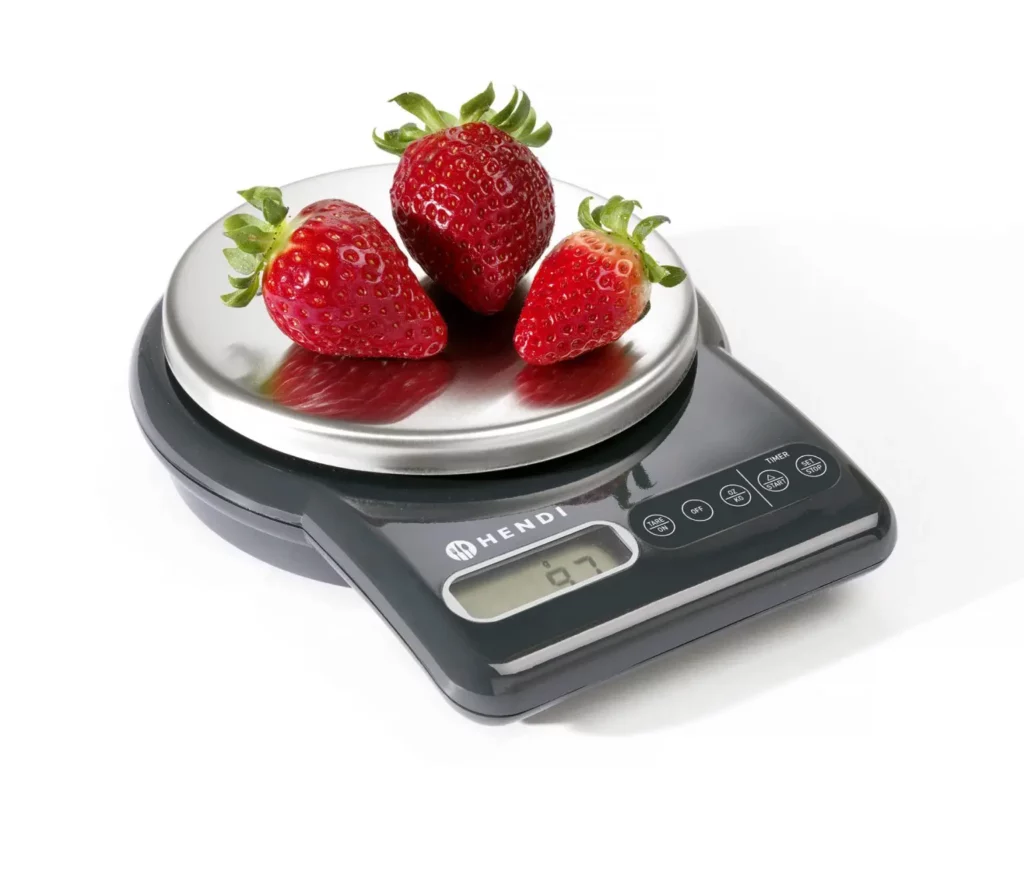
You should read this user manual carefully before using the appliance.
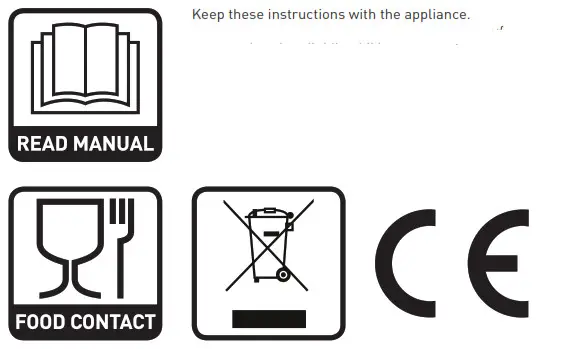
Dear Customer,
Thank you for purchasing this Hendi appliance. Before using the appliance for the first time, please read this manual carefully, paying particular attention to the safety regulations outlined below.
Safety regulations
- Incorrect operation and improper use of the appliance can seriously damage the appliance.
- This scale may only be used for the purpose for which it was designed. The manufacturer accepts no liability for damage as a result of incorrect operation and wrong use.
- Keep the scale away from water and any other liquids. If the appliance should accidentally fall into the water, have it checked by a certified technician.
- Never try to open the housing of the scale yourself.
- Do not insert any objects into the housing of the scale.
- Do not use the scale if it has been dropped or otherwise damaged. Have it checked and repaired, if necessary, by a certified repair company.
- Do not immerse the scale into the water or wash with water.
- Always place the object to be weighted at the center of the platform.
- Operate the appliance on a level, stable, clean, heat-resistant, and dry surface.
- Attention: Insert batteries (not supplied) correctly with regard to the polarities (+) and (-) that are marked on the batteries with the marking in the battery compartment.
- Remove the batteries if you do not use the scale for a long period of time.
Intended use
- The appliance is intended only for food weighting in professional use.
- Operating the appliance for any other purpose shall be deemed a misuse of the device.
- The user shall be solely liable for improper use of the device.
Electronic kitchen scale
This electronic kitchen scale combines an electronic scale with a kitchen timer. The scale is equipped with an easy-to-read, energy-saving LCD display.
Preparing the appliance for use
- Remove all the packing material.
- Insert a 9V alkaline battery (not included) in the battery compartment on the bottom of the scale.
- Press the ‘ON’ button. The scale is now ready for use.
Instructions for use
Weighing
- For optimal results, place the scale on a flat surface.
- Turn on the scale by pressing the ’ON’ button.
An ’0’ will appear on the display and the scale is now ready for use. - Select the desired measuring unit by pressing the ’OZ-KG’ button. In this way you can choose between English pounds and kilograms.
- Set an empty bowl or container on the scale. The display will now indicate the weight of the bowl or container.
- Press the ’TARE’ button to reset the scale to ’0’.
- Place the product to be weighed in the bowl or container and read its weight on the display.
- You can weigh various products in the same bowl by pressing the ’TARE’ button after adding each product, which will reset the display to ’0’ each time. Remember not to exceed the maximum weight of 5 kg.
- Turn off the scale by pressing the ’OFF’ button.
- If you do not use the scale for 5 minutes, it will turn itself off automatically.
Note: When the scale is overloaded, “Err” will be displayed.
Kitchen timer
- Turn on the kitchen timer as follows:
- Turn on the scale by pressing the ’ON’ button.
- elect the kitchen timer function by pressing the ’SET’ button. A clock symbol will appear in the top left corner of the display and (if you are using the kitchen timer for the first time) four noughts will also appear in the display: the first two noughts are for the number of minutes and the last two noughts are for the number of seconds.
- To set the timer
- Press the ’SET’ button again to set the desired time. The first digit will now begin to blink.
- Press the ’∧’ button to select the desired number. Press the ’SET’ button to select the following digit and repeat this until the correct time has been set.
- Press the ’SET’ button again; the timer has now been set.
- Press the ’START’ button to activate the kitchen timer.
- You can stop the kitchen timer by pressing on ’STOP’ and turn it off by pressing on ’OFF’.
- The activated timer will continue to operate even if the scale turns itself off automatically.
Cleaning and maintenance
- Attention: Never immerse the scale in water or any other liquid.
- Clean the outside of the appliance with a slightly damp cloth (water with mild detergent).
- Never use aggressive cleaning agents or abrasives.
Do not use any sharp or pointed objects. Do not use petrol or solvents! Do not use abrasive materials.
Technical specification
Item: 580004
Power source: 1 x 9V Battery (Not supplied)
Measurement range: 2g – 5,000g
Graduation: +/- 1g
Dimensions: 170x215x(H)55mm
Warranty
Any defect affecting the functionality of the appliance which becomes apparent within one year after purchase will be repaired by free repair or replacement provided the appliance has been used and maintained in accordance with the instructions and has not been abused or misused in any way. Your statutory rights are not affected. If the appliance is claimed under warranty, state where and when it was purchased and include proof of purchase (e.g. receipt).
In line with our policy of continuous product development, we reserve the right to change the product, packaging, and documentation specifications without notice.
Discarding & Environment
When decommissioning the appliance, the product must not be disposed of with other household waste. Instead, it is your responsibility to dispose of your waste equipment by handing it over to a designated collection point. Failure to follow this rule may be penalized in accordance with applicable regulations on waste disposal. The separate collection and recycling of your waste equipment at the time of disposal will help conserve natural resources and ensure that it is recycled in a manner that protects human health and the environment.
For more information about where you can drop off your waste for recycling, please contact your local waste collection company. The manufacturers and importers do not take responsibility for recycling, treatment and ecological disposal, either directly or through a public system.
Hendi B.V.
Steenoven 21
3911 TX Rhenen, The Netherlands
Tel: +31 (0)317 681 040
Email: [email protected]
Hendi Polska Sp. z o.o.
ul. Magazynowa 5
62-023 Gądki, Poland
Tel: +48 61 6587000
Email: [email protected]
Hendi Food Service Equipment GmbH
Gewerbegebiet Ehring 15
5112 Lamprechtshausen, Austria
Tel: +43 (0) 6274 200 10 0
Email: [email protected]
Hendi Food Service Equipment Romania Srl
Str. 13 decembrie 94A, Hala 14
Brașov, 500164, Romania
Tel: +40 268 320330
Email: [email protected]
PKS Hendi South East Europe SA
5 Metsovou Str.
18346 Moschato, Athens, Greece
Tel: +30 210 4839700
Email: [email protected]
Hendi HK Ltd.
1208, 12/F Exchange Tower
33 Wang Chiu Road, Kowloon Bay, Hong Kong
Tel: +852 2154 2618
Email: [email protected]
Find Hendi on the internet:
www.hendi.eu
www.facebook.com/HendiToolsforChefs
www.linkedin.com/company/hendi-food-service-equipment-b.v.
www.youtube.com/HendiEquipment
– Changes, printing and typesetting errors reserved.
© 2020 Hendi BV Rhenen – The Netherlands
 DISHWASHER ZMYWARKI
DISHWASHER ZMYWARKI
User manual
Item: 230299,230305,230312,230220,233023
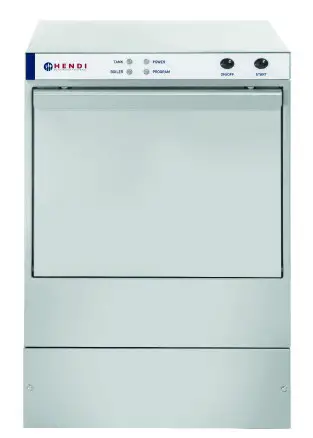 |
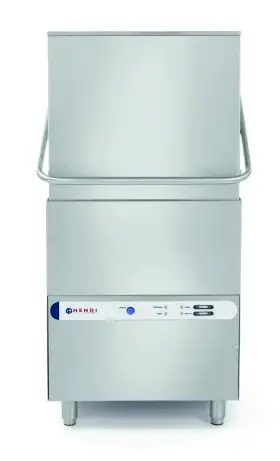 |
You should read this user manual carefully before using the appliance.
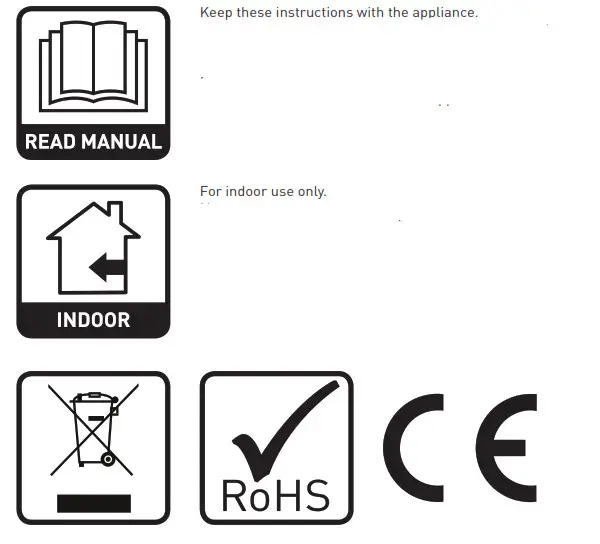
Dear Customer,
Thank you for purchasing this Hendi appliance. Before using the appliance for the first time, please read this manual carefully, paying particular attention to the safety regulations outlined below.
Safety regulations
- This appliance is intended for commercial use only and must not be used for household use.
- The appliance must only be used for the purpose for which it was intended and designed.
The manufacturer is not liable for any damage caused by incorrect operation and improper use. - Keep the appliance and electrical plug away from water and any other liquids. In the event that the appliance should fall into the water, immediately remove the plug from the socket and do not use until the appliance has been checked by a certified technician. Failure to follow these instructions could cause a risk to lives.
- Never attempt to open the casing of the appliance yourself.
- Do not insert any objects in the casing of the appliance.
- Do not touch the plug with wet or damp hands.
- Danger of electric shock! Do not attempt to repair the appliance yourself. In case of malfunctions, repairs are to be conducted by qualified personnel only.
- Never use a damaged appliance! Disconnect the appliance from the electrical outlet and contact the retailer if it is damaged.
- Warning! Do not immerse the electrical parts of the appliance in water or other liquids.
Never hold the appliance under running water. - Regularly check the power plug and cord for any damage. If the power plug or power cord is damaged, it must be replaced by a service agent or similarly qualified persons in order to avoid danger or injury.
- Make sure the cord does not come in contact with sharp or hot objects and keep it away from an open fire. To pull the plug out of the socket, always pull on the plug and not on the cord.
- Ensure that the cord (or extension cord) is positioned so that it will not cause a trip hazard.
- Always keep an eye on the appliance when in use.
- Warning! As long as the plug is in the socket the appliance is connected to the power source.
- Turn off the appliance before pulling the plug out of the socket.
- Never carry the appliance by the cord.
- Do not use any extra devices that are not supplied along with the appliance.
- Only connect the appliance to an electrical outlet with the voltage and frequency mentioned on the appliance label.
- Connect the power plug to an easily accessible electrical outlet so that in case of emergency the appliance can be unplugged immediately. To completely switch off the appliance pull the power plug out of the electrical outlet.
- Always turn the appliance off before disconnecting the plug.
- Never use accessories other than those recommended by the manufacturer. Failure to do so could pose a safety risk to the user and could damage the appliance. Only use original parts and accessories.
- This appliance is not intended for use by persons (including children) with reduced physical, sensory or mental capabilities, or lack of experience and knowledge.
- This appliance must not be used by children under any circumstances.
- Keep the appliance and its cord out of reach of children.
- Always disconnect the appliance from the mains if it is left unattended or is not in use, and before assembly, disassembly or cleaning.
- Never leave the appliance unattended during use.
Special safety regulations
- Never pull the appliance by the power lead.
- Do not apply any additional agents other than the ones supplied with the appliance.
Water softeners
 CAUTION: all appliances requiring constant connection with the water supply system (including this appliance) must have an additional water softener attached in order to remove calcium and magnesium compounds. The softener must be used in compliance with the manufacturer’s recommendations set out in the user’s manual.
CAUTION: all appliances requiring constant connection with the water supply system (including this appliance) must have an additional water softener attached in order to remove calcium and magnesium compounds. The softener must be used in compliance with the manufacturer’s recommendations set out in the user’s manual.- If the softener is not attached or is misused and/or regenerated, the distributor shall reject all complaints entailing repairs required due to the limescale build-up in the appliance.
- It is recommended to use softeners from the wide range offered by HENDI. Ask your HENDI sales representative for assistance in the selection of the appropriate model. We recommend the following agents for the proper regeneration of the softeners: Salt tablets, 25 kg bags – code: 231265
| General Hardness of water | ||||
| °dGH | °fH | mmol/l | °e | Water softener |
| above 24 | above 40 | above 4,2 | above 28 | Necessary |
| 18 – 24 | 32 – 40 | 3,2 – 4,2 | 22 – 28 | Necessary |
| 12 – 18 | 19 – 32 | 2,1 – 3,2 | 13 – 22 | Necessary |
| 4 – 12 | 7 – 19 | 0,7 – 2,1 | 5 – 13 | Necessary |
| below 4 | below 7 | below 0,7 | below 5 | Not required |
Intended use
- The appliance is intended for professional use and can be operated only by qualified personnel.
- This appliance is intended for washing crockeries, such as glasses, cups, plates and cutlery. Any other use may lead to damage of the appliance or personal injury.
- Operating the appliance for any other purpose shall be deemed a misuse of the device. The user shall be solely liable for improper use of the device.
Grounding installation
This appliance is classified as protection class I and must be connected to protective ground. Grounding reduces the risk of electric shock by providing an escape wire for the electric current.
This appliance is equipped with a cord having a grounding wire with a grounding plug. The plug must be plugged into an outlet that is properly installed and grounded.
Preparation before the first use
- Check the appliance for defects. If you discover any defects, contact your supplier without delay and DO NOT operate the appliance.
- Remove the whole packaging and the protective film.
- Clean the appliance with lukewarm water and soft cloth.
- Unless recommended otherwise, place the appliance on a flat and stable surface.
- Allow adequate space around the appliance to enable proper ventilation.
- Place the appliance in such a way that you always have easy access to the power plug.
Installation instructions
Introduction
• This appliance complies with the needs of modern and professional cooking.
• Please read these instructions carefully before operating this appliance.
• In this manual you will find all significant safety indications, as well as other essential information needed for the regular start-up – and the operation itself – of the appliance.
• The person undertaking, on behalf of the user, installation, start-up, maintenance and repair of the dishwasher should be familiar with the opera- ing instructions or trained by our customer service department. This is the only way to ensure the correct operation of the appliance and to avoid extra repair expenses.
• Keep these instructions in a safe place for future reference.
• As a condition to any warranty service obligation, the client must complete and send the Warranty Certificate to our company within 10 days of purchase date.
Advantages
This dishwasher has the following advantages:
- is made of Stainless Steel 18/8 304
- is manufactured and tested for continuous operation.
- easy and simple cleaning
- no jamming during the door opening and closing: simple use
- perfect dish and glass washing
- less environmental pollution
- excellent and friendly service; all spare parts available
- reduced water consumption
Installation suggestions
- This dishwasher is delivered with a water inlet and outlet hoses.
- According to its construction, the connection of the machine to water and power supply must be performed by an authorized and locally recognized installer by keeping the existing specifications.
Before connecting the appliance, check that the connection data on the data plate (voltage and connected load) match the mains electricity supply.
Installation
- Open the package. Before setting up the appliance, check it for any externally visible damage due to transportation. If in any doubt, call for a specialist to check it (from the authorized local dealer who sold the appliance).
- Place the dishwasher at the installation area, close to the necessary water and power supply (the ground should be sufficiently stable).
- Remove the protective foil protecting the steel housing of the dishwasher from scratches. Any remaining adhesive residue should be carefully removed. Do not use any scouring materials. Leaving the protective foil can cause difficulty removing adhesive glue foil to the dishwasher’s steel housing.
- The appliance should be placed horizontally.
Possible inclinations should be corrected using a spirit level. - Following the successful installation, the dishwasher should be cleaned thoroughly with a conventional detergent before it is put into operation.
Connection to the water supply
- ATTENTION: The connection with the water supply should be made according to the current safety standards.
- The dishwasher may be connected only to a cold water supply.* (In case you want to connect it to a hot water supply, please contact our company)
- The water supply hose should have a flap valve (non-return valve) according to DIN 1988.
- The water supply hose/pipe should be rinsed before the appliance’s connection.
- The water supply hose/pipe should have a minimum internal diameter of 16 mm and the connection with the hose should be 3/4 inch.
- All hose collars should be adjusted in a fixed position before the appliance is put into operation.
- The dishwasher can be only connected to a well-functioning softener.
- ATTENTION: The water pressure must be between 2 and 5 bar.
Drainage connection
- The outflow is accomplished through gravity force (natural flow). The outlet hose should be connected either directly to the main drainage – where a pipette for odors is anticipated, or water runs directly to the drainage well in the ground, which has a pipette for odors.
- ATTENTION: The outlet hose should not be placed higher than a level (as given for each appliance’s type) from the lower side of the dishwasher’s dispenser.
Electrical Network connection
- ATTENTION: All electrical work must be carried out by a suitably qualified and competent person.
- The dishwasher operates under a specific voltage depending on the type of dishwasher.
- You should supply the power, depending on the appliance’s power reception (the electrical connection should be made by authorized electricians). Specifications should be met according to the corresponding parts of DIN, VDE, D100, the EVU connection terms, the relevant ZH 1/37, chapter 7.2 – as well as the current specifications for accident prevention.
- Respectively, the appliance must be connected to a direct power supply electrical installation through an HO7 RN-F cable with load relief of the appliance.
Protective duct connection and voltage compensation
- The electrical safety of this appliance is ensured only if the protective duct has been connected and checked properly. The corresponding specifications should be met at this point (see paragraph 1.5).
- In addition, the appliance should include a voltage compensation system.
- For this reason, the backside of the appliance has a screw with the indication “voltage compensation”.
- Following the electrical connection, the action of the protective duct, the voltage compensation, and the insulation value should be checked according to the existing provisions of DIN VDE.
Technical specification
You can find the technical data of each appliance at the adhesive label of the dishwasher.
| Item no. | 230299 | 230305 | 230312 | 230220 |
| Intended use | Washing glass, cups up to a maximum height of 290 mm |
Washing tableware of max. Height: 325 mm for glass and 335 mm for plates |
Washing tableware of max. Height: 395 mm for glass and 400 mm for plates | Washing tableware of max. Height: 325 mm for glass and 335 mm for plates |
| Operating voltage and frequency | 230V- 50 Hz | 400V- 50 Hz | 230V- 50 Hz | |
| Rated input power | 2800W | 6600W | 8600W | 3600W |
| Protection class | Class I | |||
| Waterproof protection class | IPX4 | |||
| Amount (pcs.)/lenght
of washing cycle (s.I |
1/120 | 1/120 | 1/120 | 1/120 |
| Net weight [approx.) | 39kg | 57kg | 111kg | 39kg |
| Outer dimension | 470x510x(H1710mm | 570x6004H1830mm | 750x880x -H)1390/1830mm
570×600(+3701 |
x(H)830mm |
Remark: Technical specification is subjected to change without prior notification.
Operating instructions
Instructions for the dishwasher’s regular operation
- The appliance is exclusively used to clean dishes, cups, glasses, silverware, etc. following their use during lunches/dinners.
- You should pay special attention that the items to be washed are suitably placed for dishwashing.
- Silverware should be cleaned from food residues, if not washed right after lunch/dinner (coloring and spots from certain foodstuffs).
- Do not wash in this appliance items which have been in contact with acids, mineral oil, grease, gasoline or colors and solvents (industrial chemicals).
Preparation of dishes for washing
- Do not let food residues dry onto the dishes. In order to avoid filter blockage as well as the cleaning water becoming dirty quickly, you should remove large food residues, olive pips, lemon peels, toothpicks, etc., before you place the dishes in the basket.
- We recommend you to leave in water for a while or rinse the glassware that has food residues dried on.
Filling of basket
- Put glasses, cups, large plates, etc. with the opening facing down in the anticipated baskets. Do not pile one on top of the other.
- Glasses should not touch each other (damage in glass, stains due to contact).
- Place cutlery in the appropriate basket made of synthetic material, with the handle facing down.
- Silverware may be placed freely on the leveled plastic basket.
- In any case, you should avoid overloading the basket.
- Water supply hoses should remain free (not blocked or stretched).
- The detergent to be used should be suitable for dishwashers. After the recommended operating temperature is accomplished, you may put the detergent directly into the dispenser.
- If the dishwasher has an integrated detergent pump, we put the pump’s elastic pipe indicated as DETERGENT in the detergent dispenser.
- Use exclusively detergent with little foam effect.
- We recommend that you use detergent and rinse aid from the same manufacturer.
Rinse-aid dozer
- The dishwashers have an automatic rinse aid dozer. Put the elastic pipe indicated as “RINSE AID” in the storage compartment.
- The dozer is adjusted from the manufacturer’s premises at its maximum value and may be adjusted accordingly – depending on water hardness, how dirty the dishes are, and the detergent used – following the successful installation of the dishwasher.
- Turning the adjustment screw clockwise, the flow is reduced (-), turning it counter-clockwise the low is increased (+). We recommend that you let the constructor to adjust it (or the specialized personnel of the authorized local dealer who sold the appliance).
ATTENTION: Do not use detergent for hand-wash.
- The correct detergent dosage depends on the water hardness and the amount of dirt on the dishes. Follow the dosage information of the detergent’s manufacturer.
- Less detergent quantity affects negatively the washing result, while more detergent quantity does not present better results, but rather more consumption and environmental pollution.
- Before you perform these works, you should turn off the switch of the appliance or turn off the corresponding switches so that no current flows, or turn off the power supply switch.
- INDICATION: The dozer should not operate while dry, since it will lose its suction properties. It is necessary that you have filled the storage compartment before the appliance’s installation so that the dozer operates correctly during the first wash.
- Do not use caustic products. If you do not follow this indication, you will not be covered by the guarantee.
Control panel operation
Start of the washing program in glass rinser 230299 and dishwasher 230305
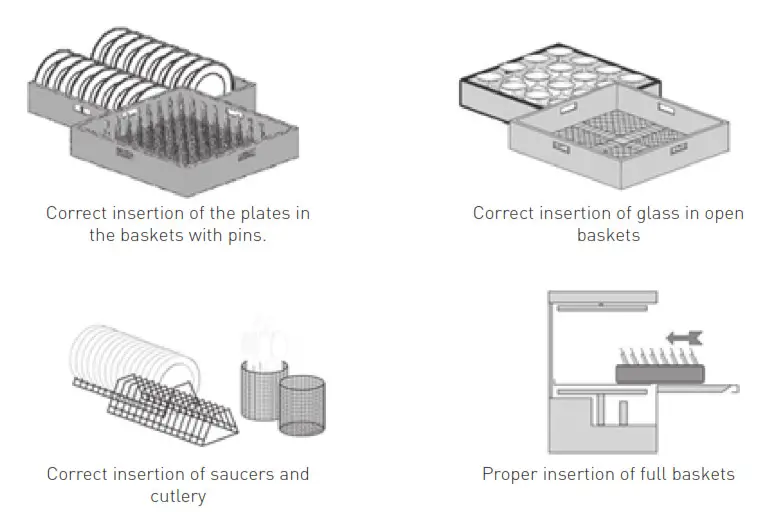
- Open the main external water control valve and press on the power safety switch dedicated to the cup washer.
- Make sure the tank filter “B” of the cup washer has been properly placed in the bottom (see figure opposite).
- Make sure the overflow pipe “A” (overflow tube) has been fitted properly (see figure opposite).
- Turn on the cup washer by pressing the “ON/ OFF” button – the green “POWER” indicator will light up – this means that the appliance is powered on.
- The cup washer tank starts filling with water (on the first start-up of the appliance, the boiler will start filling first).
- When the tank is full, the boiler heater will come on followed by the tank heater – this is signaled by the lighting up of the orange “TANK” indicators for the tank heater and “BOILER” indicator for the boiler heater. The heating time is about 30-40 minutes. Do not start the washing cycle until the heater indicators turn off – the water will not be hot enough.
- When both the orange indicators turn off, put the rack with crockery, close the washer’s door and start the washing cycle by pressing and holding the “START” button down for 5 seconds. During the washing cycle, the green “PROGRAM” indicator will remain lit. If the “TANK” and/or “BOILER” indicator turns on during the washing cycle, it is a normal event and indicates the operation of the heater.
- The full washing cycle lasts 2 minutes. It is composed of 1 min. 40 sec. of the main washing with water heated to +62°C and of 20 sec. of rinsing/scalding with water heated
to +85°C. - When the washing cycle ends, the “PROGRAM” indicator will turn off and the cup washer is ready for another washing cycle.
- To start another washing cycle, repeat the steps from 7 to 9.

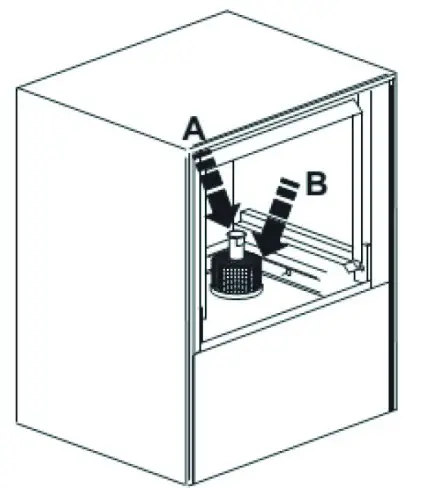
CAUTION: It is recommended to start subsequent washing cycles when the “TANK” and “BOILER” indicators are off.
Dishwasher 230305 has an additional component of the control panel – a boiler water thermometer. When the dishwasher is operating correctly, the thermometer reading should be +85°C (or more).
Start of the washing program in hood dishwasher 230312
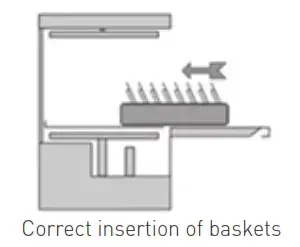
- Open the main external water control valve and press on the power safety switch dedicated to the cup washer.
- Make sure the tank filter “B” of the cup washer has been properly placed in the bottom (see figure opposite).
- Make sure the overflow pipe “A” (overflow tube) has been fitted properly (see figure opposite).
- Turn on the cup washer by pressing the “ON/OFF” button – the green “POWER” indicator will light up – this means that the appliance is powered on.
- The cup washer tank starts filling with water (on the first start-up of the appliance, the boiler will start filling first).
- When the tank is full, the boiler heater will come on followed by the tank heater – this is signaled by the lighting up of the orange “TANK” indicators for the tank heater and “BOILER” indicator for the boiler heater. The heating time is about 40-50 minutes. Do not start the washing cycle until the heater indicators turn off – the water will not be hot
enough. - When both the orange heater indicators turn off, lift the hood – then the orange “DOOR” indicator will light up – and put the rack with crockery (see figure opposite), close the dishwasher door. The washing cycle will start automatically when the hood is pulled down. During the washing cycle, the green “PROGRAM” indicator will remain lit. If the “TANK” and/or “BOILER” indicator turns on during the washing cycle, it is a normal event and indicates the operation of the heater.
- The full washing cycle lasts 2 minutes. It is composed of 1 min. 40 sec. of the main washing with water heated to +62°C and of 20 sec. of rinsing/scalding with water heated to +85°C.
- When the washing cycle ends, the “PROGRAM” indicator will turn off and the cup washer is ready for another washing cycle.
- To start another washing cycle, repeat the steps from 7 to 9.

CAUTION: When the hood is not closed properly, the dishwasher will not start; instead, the “DOOR” indicator will light up.
Hood dishwasher 230312 has additional components of the control panel – a boiler water thermometer and a tank water thermometer. When the dishwasher is operating correctly, the boiler water thermometer should read +85°C and the tank water thermometer 62°C.
General comments regarding all models of honda dishwashers
- When the “TANK” indicator turns off, the dishwasher is ready to wash.
- Before you insert the rack, make sure all the food residues are removed.
- Add liquid detergent to the dispenser by hand unless the dishwasher is fitted with a detergent dispenser. See if there is enough shine and rinse agent and detergent in the inside tanks.
- When the washing program ends, the “PROGRAM” indicator will come off. Open the door and remove the ack with clean crockery.
- Leave to dry.If there are any dirt stains or watermarks after the washing cycle, this may be due to:
- inappropriate amount of detergent,
- the large mineral content of the rinse water,
- insufficient amount of shine and rinse agent,
- incorrect arrangement of the dishes in the rack,
- low water pressure during rinsing,
- low temperature of the water during rinsing,
- clogging or improper fitting of the filters,
- dirty water in the tank and/or boiler.
Safety arrangements
- There is a safety adjustment at the door, which interrupts the appliance’s operation during washing if the door opens by mistake. There is thermal protection integrated into the pump motor winding with automatic start-up, which interrupts power supply to the pump, in case of overcharge.
- There are thermal safety fuses, which interrupt the power supply in case of boiler or dispenser overheating.
Further significant indications / Safety indications
- No technical modifications are allowed in this appliance. The manufacturer is not responsible for any possible damages resulting due to modifications.
- The same applies in case that the appliance is used for any other purpose except the one anticipated, in case of fault or improper use. The water inside the dishwasher is not potable.
- Use, maintenance, and repair of dishwashers should be performed only by persons familiar with these works and informed of any possible risks.
Daily works
- Turn off the operation switch
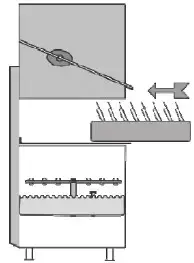 of appliance 230312.
of appliance 230312. - Turn off the main switch/fuses.
- Turn off the water supply faucet.
- Empty the dishwasher by removing the overflow pipe “A” (overflow pipe) but leaving the Pump filter “B”.

Maintenance / Care / Repair
The perfect operation and safe use may be ensured only through the correct use of the appliance, as well as the compliance with the operation instructions, the corresponding
specifications and the care and cleaning indications.
This applies both for the compliance of the provisions of the law on appliance safety (GSG) and the existing specifications of ZH 1 and VBG on accident prevention.
RECOMMENDATION: Before cleaning or maintenance works, the appliance should not be connected with voltage through the installed main switch/fuse. The appliance should never be sprayed with water or high-pressure cleaning aid, because any insertion of water in the electrical elements may affect the regular operation of the appliance as well as the protection against electrical shock (insulating protection).
We recommend that you prepare a relevant maintenance agreement for all maintenance and repair works with our company (or with a service team/workshop of an authorized local dealer who sold the appliance).
All works/repairs performed in this appliance must be reported on the last page of the operating instructions, along with the signature/company name.
Substantially, no safety the arrangement should be put out of operation. If the disassembly of individual safety arrangements is required, e.g. for maintenance or repair works, the reassembly of the relevant safety arrangements should be performed immediately after the completion of works.
Unloading the water from the dishwasher’s tank (dispenser)
- Turn OFF the power of the dishwasher
- Empty the washing dispenser removing the overflow hose A.
- Remove filter B and clean it carefully with water.
- Rinse the washing compartment to remove any dirt residues.
- Then, reassemble the parts in reverse order. The appliance should never operate without a filter.
- During non-operation, the door should remain half-open or completely open (in order to avoid odors).
Regular maintenance and cleaning works
Regularly, you should remove the rotating arms and sprinkler, clean them carefully with water and reposition the parts in reverse order. This work should be performed with great care.
Pay attention to the correct position of filters and sprinklers!
- Do not clean the sprinkler’s injectors with tools or sharp objects.
- You may clean the appliance with warm water and conventional cleaning aids. Rub with water and then let it dry. The stainless steel parts should be treated with special means for steel and you should never clean them with steel wire, brush, etc. Also, you should never let them touch the surface, since even the slightest contact with the surfaces may cause rust formation. You should use brushes made of polymer plastic or natural brushes or thin wire.
- You should take care to move towards the smoothing direction so that you will not scratch the surface. Finally, rinse with clean water and dry thoroughly.
- We remind you that corrosion (rust formation) on stainless steel surfaces is not created by itself, but rather due to the use of improper cleaning aid (e.g. whitening or particularly caustic cleaning aid based on chlorine). Following a particular period of use, calcium sediments are formed in the internal walls of the dispenser (due to mineral particles in the water), which may affect the correct operation of the appliance. For this reason, regular emoving of salt formations is required.
- We recommend letting this work (removing of salt formations) be performed by specialized personnel (or by an authorized local dealer who sold the appliance).
Spare parts, Accessories, and Components
- All spare parts and components can be found in the authorized local dealer, who sold this appliance, or directly in our company.
- In case of claims or complaints, you should necessarily report the model and the serial number of the appliance/machine. These can be found on the label that is attached to the appliance.
| PROBLEM | CAUSE | SOLUTION |
| The dishwasher does not operate properly | Connection interruption | Check the connection |
| You have not turned the switch off the appliance ON | Turn the switch ON | |
| The main switch / or fuse has not been activated / or it is faulty |
Check the main switch / or fuse | |
| The switch of the appliance is faulty |
Refer to the authorized local a dealer who sold the appliance or directly to the manufacturer |
|
| The water inlet valve is faulty | ||
| The door is not closed | Close the door | |
| You have not turned the water supply on |
Turn the supply on | |
| The appliance operates, but the switch LED does not light on | The LED is faulty | Change the LED |
| Boiler heating does not operate | Switch or main switch or fuse has not been activated |
Check the switch of the appliance and the main switch or fuse |
| The safety thermostat of the boiler is faulty |
Refer to the authorized Local dealer or the manufacturer |
|
| The 93° thermal fuse of the boiler is faulty |
||
| The pressure regulator is faulty | Refer to the authorized Local dealer or the manufacturer |
|
| -Boiler heating” relay is faulty | ||
| The boiler fuse is burned out | Refer to the authorized local dealer or the manufacturer |
|
| Boiler heating operates, but LED does not turn on | Faulty LED | Change LED |
| Dispenser heating does not operate | Switch NI of the appliance or main switch or fuse has not been activated |
Activate the corresponding switch or fuse |
| Boiler heating is open | Wait | |
| The 85° thermal fuse is faulty. The dispenser’s fuse is burned out | The thermostat switch of 60° heating is faulty |
Refer to the authorized local dealer or the manufacturer |
| -Compartment heating” relay is faulty |
||
| Dispensers heating operates, but LED does not turn on | Faulty LED | Change LED |
| The pump motor does not operate | The main switch or fuse is not activated. The door is not closed. |
Activate the main switch or fuse |
| Close the door | ||
| The main relay is faulty | Refer to the authorized local dealer or the manufacturer |
|
| The pump motor is faulty | ||
| The program selection switch is faulty | ||
| The motor operates, but the pump does not rotate | An object has jammed the pump fin | Refer to the authorized local dealer or the manufacturer |
| Salts or detergent have been petrified following non-operation of the appliance |
Rotate the screw on the backside of the motor, until it rotates freely |
|
| Items do not dry (dishes, glasses, etc.) | The compartment has no drying aid | Insert drying aid to the compartment |
| The drying valve is faulty | Refer to the authorized local dealer or the manufacturer d | |
| The program switch is faulty | ||
| Rinsing arms do not rotate | ||
| The basket does not rotate |
Warranty
Any defect affecting the functionality of the appliance which becomes apparent within one year after purchase will be repaired by free repair or replacement provided the appliance has been used and maintained in accordance with the instructions and has not been abused or misused in any way your statutory rights are not affected. If the appliance is claimed under warranty, a state where and when it was purchased and include proof of purchase (e.g. receipt). In line with our policy of continuous product development, we reserve the right to change the product, packaging, and documentation specifications without notice.
Discarding & Environment
When decommissioning the appliance, the product must not be disposed of with other household waste. Instead, it is your responsibility to dispose of your waste equipment by handing it over to a designated collection point. Failure to follow this rule may be penalized in accordance with applicable regulations on waste disposal. The separate collection and recycling of your waste equipment at the time of disposal will help conserve natural resources and ensure that it is recycled in a manner that protects human health and the environment. For more information about where you can drop off your waste for recycling, please contact your local waste collection company. The manufacturers and importers do not take responsibility for recycling, treatment, and ecological disposal, either directly or through a public system.

Hendi B.V.
Steenoven 21
3911 TX Rhenen, The Netherlands
Tel:+31 (0)317 681 040
Email: [email protected]
Find Hendi on internet:
www.hendi.eu
www.facebook.com/HendiFoodServiceEquipment
www.linkedin.com/company/hendi-food-service-equipment-b.v.
www.youtube.com/HendiEquipment
– Changes, printing and typesetting errors reserved.
© 2019 Hendi BV/PL Rhenen – The Netherlands
Ver: 28-10-2019
]]>
You should read this user manual carefully before using the appliance.
EQUIPMENT ILLUSTRATION
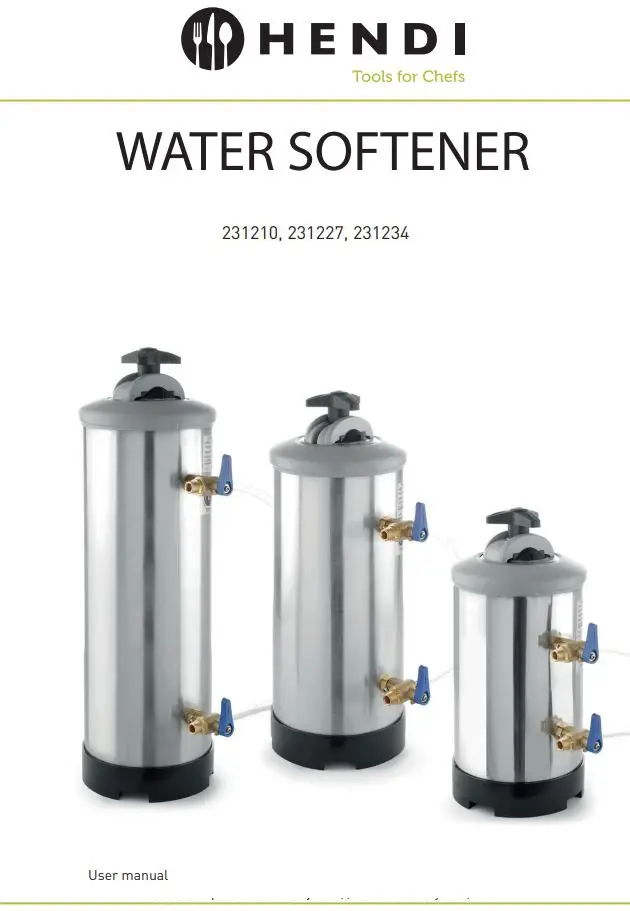
LEGEND (fig. 1):
- A. WATER INLET PIPE
- B. WATER OUTLET PIPE
- C. WATER INLET TAP
- D. WATER OUTLET TAP
- E. DEPRESSURIZATION PIPE
- F. REGENERATION PIPE
- G. TANK LID
- I. CHECK VALVE
- L. LABEL
- M. STANDARD TAP
- N. FLOOR SINK
RINSING AND ACTIVATION
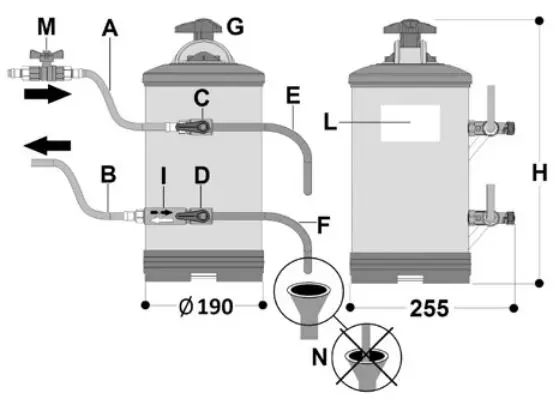

SERVICE MODE
DEPRESSURIZATION AND SALT-REFILLING MODE
CLEANING
RINSING MODE
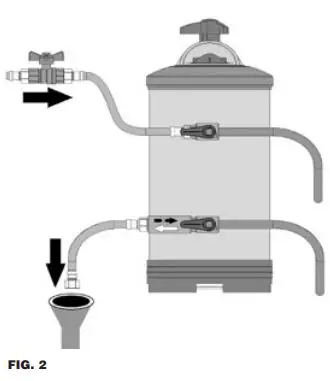
WARNINGS FOR THE USER
– This equipment must not be used by children or by people with physical, mental or sensory impairments, or by people lacking experience, unless they be supervised by someone responsible for their safety, or they received instructions regarding the correct and safe way to use the equipment and were warned of the risks.
– Never try to repair the equipment by yourself: you may cause damage. Ask your seller for assistance.
– Never touch or use the water softener with wet or damp hands or feet, or barefoot.
1. INTRODUCTION AND GENERAL INFORMATION
1.1 OBJECTIVE OF THE MANUAL
This instruction manual is addressed to qualified personnel who must have knowledge of the health and safety norms of the place of installation. The objective of this manual is to give useful information and warnings, both to the installer and the user, regarding:
HOW TO STORAGE AND KEEP THE EQUIPMENT BEFORE USE:
- Place and room conditions
- Expiry date
FOR THE INSTALLER - Precautions for hygienic safety
- Equipment description and characteristics
- Place and mode of installation
- Activation
- Procedures to follow after a period of inactivity of the equipment
- Equipment disposal
- Solutions to some problems
FOR THE USER - Instructions for the periodic rinsing of the resins
- Instructions for the care and cleaning of the equipment
- Health and hygiene warnings concerning the water produced by the equipment
The manual also gives you the guidelines to avoid an improper use of the equipment and it specifies the installer and the user’s responsibilities, therefore we suggest reading through this manual before installing or using the water softener. If the dispositions are not followed, the manufacturer will decline responsibility for any damage caused to people, things or animals, and will consider the guarantee null and void.
1.2 KEEPING THE MANUAL
This manual is an integral part of the product. It must be kept with care by the user and it must accompany the equipment, even in case of a propriety transfer.
1.3 EQUIPMENT IDENTIFICATION
The equipment is identified by the numbers written in bold on the bottom left side of the label (fig. 1, L) on the softener’s tank, on the package and on the back of this manual.
1.4 DECLARATION OF COMPLIANCE
This product complies with the Community Regulations and national laws applicable at the moment of its entrance on the market. The declaration of compliance signed by the manufacturer is available on request and online.
1.5 HYGIENIC SAFETY NORMS AND ICIM TESTING
This equipment has been tested by the ICIM Institute of Italian
Instruction Manual Water Softener Certificated for the Mechanic, licensed credited labor-tory , certificated to the compliance with:
• Reg. n.1935/2004/CE products and components contact with elements according to the dispositions MOCA.
• D.M. n.174/2004 products and components utilized in contact with feed water.
It is NECESSARY to use original replacements for repairs and maintenance, to guarantee hygienic safety. To preserve hygienic safety, we commend removing the equipment from the package only at the moment of installation.
1.6 RECOMMENDATIONS AND WARNINGS
FOR THE STORAGE:
- Storage the water softener in a dry place
- The temperature in the storage must be between 0 – 35 °C
- We recommend using the equipment within 24 months
FOR THE INSTALLER We suggest installing the equipment after carefully reading the instruction manual. Should complications arise, we suggest asking your seller for assistance. The seller’s information is written on the last page of this manual.
FOR THE USER
- Never try to repair the equipment by yourself: you may cause damage. Ask your seller for assistance.
- For manual regeneration and regular salt refilling’s, read the
“ACTIVATION AND INSTRUCTIONS FOR REGENERATION”. - Cleaning the water softener is part of the user’s duties.
The manufacturers are not responsible for any damage or harm that may derive by not following these precautions.
2. ABOUT THE EQUIPMENT
2.1 HOW DOES IT WORK?
The cationic resins in the softener’s tank transform calcium carbonate in sodium carbonate, which is water-soluble at the working temperatures of both coffee makers and ice makers machines. The transfer of sodium ions between the resins and water is imperative to soften drinking water, but this process tends to decline in proportion to the flow rate and the consumption of water. For this reason, it is necessary to regenerate the exhausted resins by making water and salt flow through them, therefore returning them to their active state. The resins gradually lose their cationic function, and consequently their efficiency, with each regeneration. We recommend replacing them after seven years of use.
2.2 EQUIPMENT DESCRIPTION
(fig. 1) The main components of the water softener are:
- 1 tank containing the resins for water softening
- 2 three-way taps (fig. 1, C-D)
- 1 tank lid (fig. 1, G)
2.3 THE PACKAGING CONTAINS
- 1 complete water softener
- 1 instruction manual
- 2 drain pipes (fig. 1, E-F)
2.4 TECHNICAL FEATURES
Pressure of feed water:. . . . . . . . 0,1 ÷ 0,8 MPa (1 ÷ 8 bar)
Nominal flow rate at 4 bar: . . . . . 1000 l/h
Room temperature: . . . . . . . . . . 4°C – 35°C
Joints for the connection to the water system:3/8″G; 3/4″G (fig. 3)
2.5 CHARACTERISTICS OF FEED WATER
Feed water must be:
- Drinkable and clean (SDI 1)
- Temperature must be between 6° and 25°C
- Hardness must be below 900 ppm CaCO3 (90°f)
2.6 EQUIPMENT PERFORMANCE BASED ON WATER HARDNESS
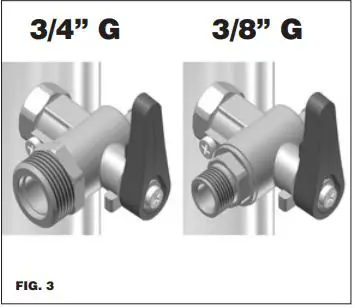
3. INSTALLATION
3.1 PACKAGING
- Before the installation, check that the equipment was not damaged by the transport and does not show any anomaly. If in doubt, ask your seller, whose information is written on the back of this manual.
- Don’t throw the package away for some time, being careful to keep any dangerous or small parts of the package away from children.
3.2 CHOOSING THE PLACE OF INSTALLATION
- Ensure that any other water treatment machine is not present upline of the place of installation.
- Ensure that feed water comes from a drinking water pipe.
We recommend checking the chemical and physical parameters of the drinking water as well as its hardness before installation. - Install the equipment near a floor sink, to dispose of the waste water produced by the regeneration.
- Install the equipment in a dry place that can be easily accessible to maintain, regenerate and clean the equipment. Do not install the equipment in dirty and unhygienic places, or in any place difficult to clean.
- Ensure that room temperature in the place of installation is between 4°C and 35°C.
- Keep away from corrosive or acid products.
- Do not install in places where electric safety norms or personal safety norms are openly disregarded.
- Hydric pressure must not be under 0.1 Mpa (1 bar) or over 0.8 Mpa (8 bar). (We recommend at least 3 or 4 bar)
- If hydric pressure is over 8 bar, it is necessary to install a pressure adaptor.
- Salt packages or boxes must not be kept in humid places or in direct contact with the floor: keep it, for example, on a wooden pallet.
3.3 CONNECTION TO THE WATER SYSTEM (fig.1)
The connection of the equipment to the water system must be done according to all applicable norms, following the instructions of the manufacturer and qualified personnel. During the installation use pipes, hoses, valves and components which comply with the applicable Italian norm on hygienic safety, the Ministerial Decree 174/2004. They must be kept in their sealed package until the moment of installation to preserve their hygienic safety. It is forbidden to use components that are not suitable for drinking water contact, or components which hygienic safety was compromised, as they could corrupt the quality of treated water and the equipment itself. Connect the water inlet (fig. 1, A) and outlet (fig.1, B) to the connection joints (fig.3) of the water softener, tightening them safely
Ensure that:
- The water inlet and outlet pipes (fig. 1, A and B) comply with the norms on drinking water pipes.
- The water inlet pipe (fig 1, A) has an internal diameter of at least 7 mm.
- A standard tap (fig. 1, M) must be installed by the user between the water system and the water softener, to ensure that water flow can be interrupted in case of necessity.
- Install on the water outlet a check valve (fig. 1, I) (DVGW, DIN 1988 T2) to protect the water softener from a reverse flow of hot water that could cause damage.
- Install a tap to take a sample of the outlet water, to test its hardness. All pipes must be free, not crushed or constricted.
3.4 CONNECTION TO THE DRAIN SYSTEM
Waste water resulting from the regeneration is funneled into the floor sink by the flexible pipe (fig.1, F) included in the package.
Warning: keep the drain pipe suspended over and not immersed in the water of the sink (fig. 1, N).
At the end of the installation, before opening the water inlet and outlet taps (fig. 1, C-D), rinse the resins as explained in the chapter “Activation and instructions for the regeneration”.
4. ACTIVATION AND INSTRUCTIONS FOR THE REGENERATION
4.1 RINSING THE RESINS (fig. 2)
Put the water outlet pipe in the floor sink. Turn the tap levers on the left and open the standard tap to let the water in. Let the water flow until it is clear, then close the standard tap (fig.1, M) and connect the water outlet pipe to the machine of your choice.
4.2 PERIODIC REGENERATION (fig. 4)
• Position B (DEPRESSURIZATION MODE)
1) Put the depressurization pipe in a bucket (fig. 1, E and fig. 4, position B)
2) Turn the tap levers on the right and wait until depressurization.
3) Remove the lid (fig. 1, G) and add the required quantity of Instruction Manual Water Softener salt according to the model (see the table at paragraph 2.6)
• Position C (CLEANING)
Clean the lid and the seal (fig. 4, C) from any salt residue. Clean the upper part of the water softener from any salt residue and clean the tank and under the cover of the weld joint of any leaked salt water.
The manufacturer does not take responsibility for the corrosion of the tank caused by the failure to follow these instructions.
4) Put the lid back on and tighten it.
• Position D (RINSING MODE)
5) Turn the water inlet tap lever (fig. 1, C) on the left
6) Let the salt water come out from the drain pipe until the water is fresh (around 40 minutes)
• Position A (SERVICE MODE)
7) Put the water softener back in service mode by turning the water outlet tap lever back on the left (fig.1, D)
WARNING: during the regeneration, the machine connected to the water softener does not receive drinking water.
5. MAINTENANCE FOR THE INSTALLER:
5.1 CHANGING THE RESINS
The resins’ softening capacity ends after 5-7 years. This period can change based on the characteristic of the feed water and the quantity of softened water. After this period of time, the user needs to decide if it is enough to change the resins or if it is better to change the water softener itself. To change the resins it is necessary to disconnect the water softener and bring it to an appropriate place. To disconnect the water softener:
- 1) Close the main water inlet tap (fig. 1, M)
- 2) Put the depressurization pipe in a bucket (fig. 1, E and fig. 4, Position B).
- 3) Turn the tap levers on the right, as in fig. 4, Position B.
- 4) Wait a few seconds until depressurization.
- 5) When water stops coming out of the depressurization pipe (fig. 1, E) it is possible to unscrew the inlet and outlet pipes (fig. 1, A and B) from the joints (fig. 3).
- 6) Open the lid (fig. 1, G) and change the resins. Clean the interior of the tank before inserting the new resins.
Do not throw the exhausted resins in the sewers. The resins are not biodegradable and must be considered a non-hazardous waste (EU code CER 190905). After changing the resins, clean the lid seal and the upper part of the softener from any resin residue. - 7) Close the lid (fig. 1, G) and bring the softener back to its installation place.
- 8) Connect the water inlet and outlet pipes to the joints (fig. 3) and tighten them.
- 9) Rinse the resins as explained in paragraph 4.1.
5.2 RESIN PRESERVATION AND ACTIVATION AFTER A LONG PERIOD OF INACTIVITY
If the water softener is not to be used for more than 30 days, it is necessary to do a double regeneration first and then leave the water softener with the lid (fig. 1, G) closed. We suggest avoiding a period of inactivity longer than 12 months. It is forbidden to reactivate the system after this period of inactivity. If the period of inactivity is shorter than 12 months, it is necessary to rinse the resins and do a manual regeneration (paragraph 4.1 and 4.2) before reactivating the equipment.
6. IMPROPER USE OF THE EQUIPMENT
This equipment has been created to soften drinking water for domestic and technological use. The equipment must not be used for any other purpose and it must not be modified or tampered with in any way. Any other use than the one specified in this manual is improper and therefore dangerous. The manufacturer cannot be considered responsible for any damage caused by improper, mistaken or illogical use of the equipment.
- It is forbidden to feed the equipment with any liquid other than drinking water.
- It is forbidden to introduce in the tank any products other than salt (NaCl)
7. EQUIPMENT DISPOSAL
EQUIPMENT FOR DOMESTIC TREATMENT OF DRINKING WATER
This equipment is a water softener for domestic use, to be connected exclusively with the water system. The following values refer to a test on 2540 liters, with domestic drinking water and 1 cycle of manual regeneration, in compliance with ICIM internal regulations on testing. The parameters comply with the values indicated by the Italian norms on the subject, the Legislative decree n.31, February 2, 2001, and following transpositions.

The drinking water-contact materials of the water softener comply with the parameters requested by the Italian laws (D.M. 6 Aprille 2004, n.174).
WARNING: this equipment needs periodic maintenance to guarantee the treated drinking water requirements and to maintain the features declared by the manufacturer.
THE EQUIPMENT MUST BE USED FOLLOWING THE RULES IN THE MANUAL

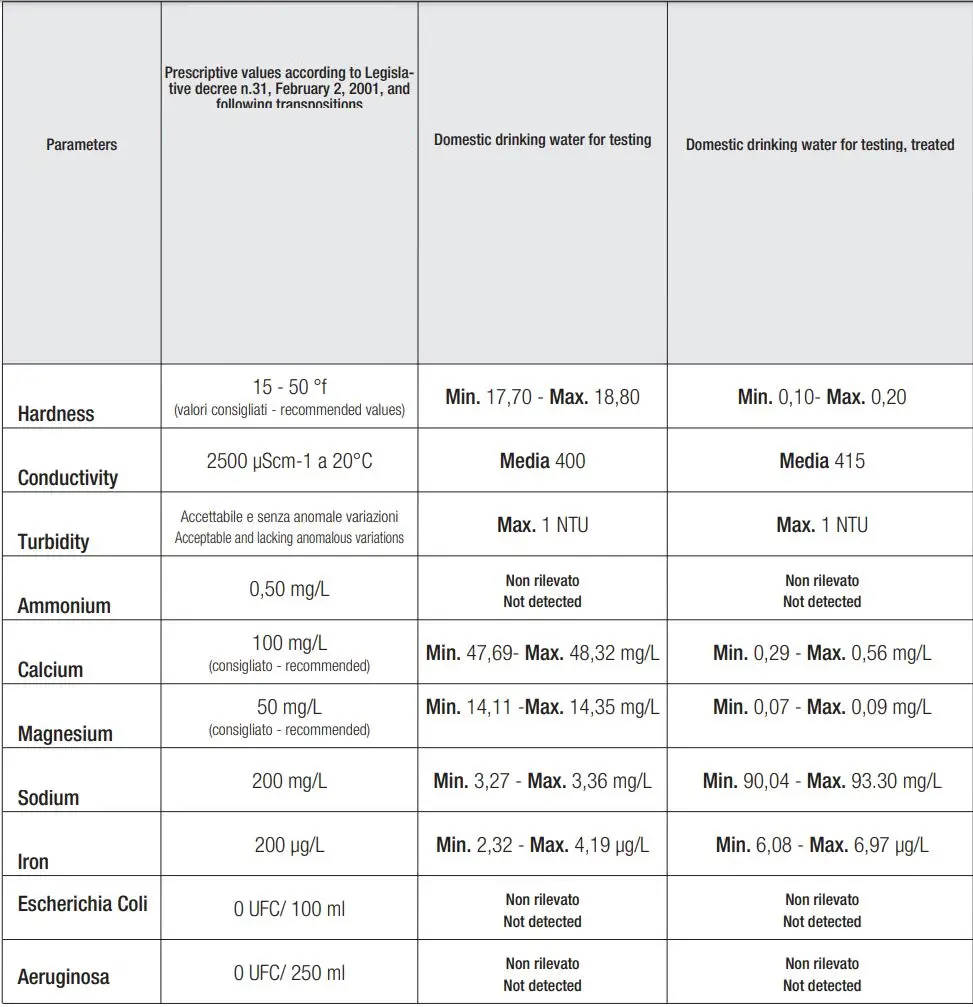
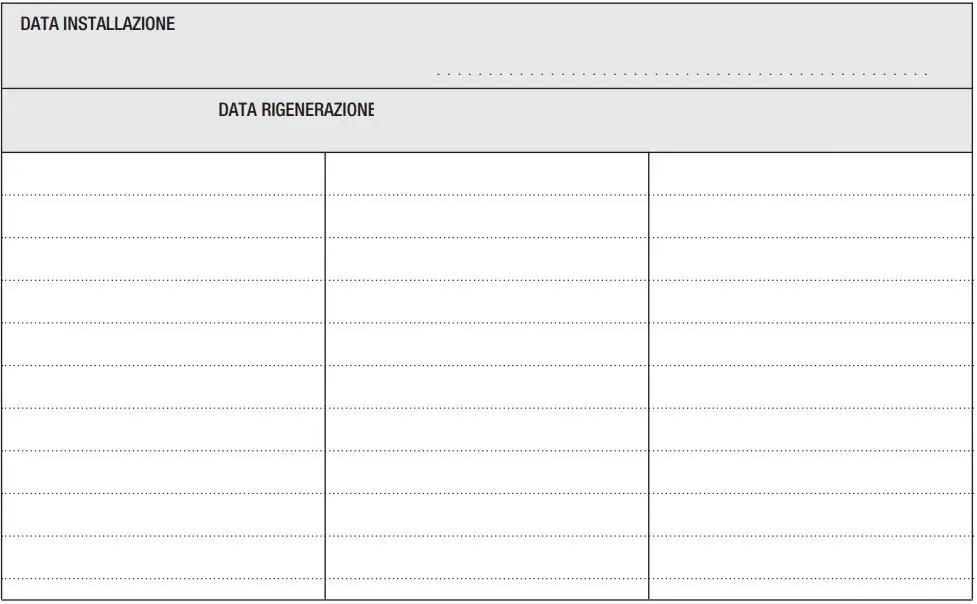
Hendi B.V.
Steenoven 21 3911 TX Rhenen, The Netherlands
Tel: +31 (0)317 681 040
Email: [email protected]
Hendi Polska Sp. z o.o.
ul. Magazynowa 5 62-023 Gdki, Poland
Tel: +48 61 6587000
Email: [email protected]
Hendi Food Service Equipment GmbH
Gewerbegebiet Ehring 15 5112 Lamprechtshausen, Austria
Tel: +43 (0) 6274 200 10 0
Email: [email protected]
Hendi UK Ltd.
Central Barn, Hornby Road Lancaster, LA2 9JX, United Kingdom
Tel: +44 (0)333 0143200
Email: [email protected]
Hendi Food Service Equipment Romania Srl
Str. 13 decembrie 94A, Hala 14 Braov, 500164, Romania
Tel: +40 268 320330
Email: [email protected]
PKS Hendi South East Europe SA
5 Metsovou Str. 18346 Moschato, Athens, Greece
Tel: +30 210 4839700
Email: [email protected]
Hendi HK Ltd.
1208, 12/F Exchange Tower 33 Wang Chiu Road,
Kowloon Bay, Hong Kong
Tel: +852 2154 2618
Email: [email protected]
Find Hendi on internet:
www.hendi.eu
www.facebook.com/HendiFoodServiceEquipment
www.linkedin.com/company/hendi-food-service-equipment-b.v.
www.youtube.com/HendiEquipment
– Changes, printing and typesetting errors reserved.
]]>
HENDI 222805 Sausage cutter
 Important note:
Important note:
- This sausage cutter is for cutting sausage & soft food only.
Otherwise, it may damage this cutter. - When the blades become loose, please tighten the knobs at 2 sides.
Introduction
- CHECK FOR DAMAGED PARTS. Before using the cutter, check that all parts are included in the package, and that any moving parts are operating properly for performing the intended functions.
Check for alignment of moving parts, binding of moving parts, and any other conditions that may affect the operation. - The manufacturer declines any responsibility in case of improper use of the cutter. Improper use of the cutter voids the warranty.
- Operating the cutter to keep hands away from the blades.
- NOT DISHWASHER SAFE! Hand-wash all parts that come in contact with food in warm, soapy water before and after each use, rinse with clear water. Dry all parts thoroughly before re-assembly. Cutting plates have sharp edges, handle with care!
- BEWARE! Moving parts create pinch points when in use, keep fingers and loose clothing away! Injury may result.
- KEEP CHILDREN AWAY.NEVER LEAVE THE CUTTER UNATTENED.
Getting familiar with your sausage cutter
The diagram below shows you the basic parts of your sausage cutter.

Cleaning instructions
IMPORTANT: EXTREME
CAUTION: BLADES ARE VERY SHARP
- Completely hand wash all parts that come in contact with food.
- Clean with warm, soapy water after each use. Rinse with clean water. Dry all parts completely.
Hendi b.v.
For technical information and Declarations of Conformity see www.hendi.eu.

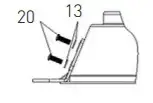 PATIO HEATER
PATIO HEATER272602, 272701
 You should read this user manual carefully before using the appliance.
You should read this user manual carefully before using the appliance.
 Keep these instructions with the appliance.
Keep these instructions with the appliance.
 Use outdoors only.
Use outdoors only.

 Innovatielaan 6, 6745 XW De Klomp,The Netherlands www.hendi.eu Innovatielaan 6, 6745 XW De Klomp,The Netherlands www.hendi.eu |
 |
||||||
| Item | 272602 Patio Heater | PIN : 0063CO7365 | |||||
| Country | NL/DE/AT/CH | BE/FR/LU/GB/IE/GR/IT | AT/CH/HR | RO/IT/HU | CZ/SK | PL | |
| Power | [HS] 12,5 kW | [HS] 10 kW | [HS] 13,5 kW | [HS] 9 kW | [HS] 10 kW | [HS] 12 kW | |
| Category | I3P | I3P | I3B/P | I3B/P | I3+ | I3B/P | |
| Consumption | 909 g/h | 715 g/h | 982 g/h | 643 g/h | G30: 728 g/h, G31: 715 g/h |
873 g/h | |
| Set up | G31-50 mbar | G31-37 mbar | G30/31-50 mbar |
G30/31-30 mbar |
G30-28-30 mbar, G31-37 mbar |
G30/31-37 mbar |
|
| Serial no. | |||||||
 Innovatielaan 6, 6745 XW De Klomp,The Netherlands www.hendi.eu Innovatielaan 6, 6745 XW De Klomp,The Netherlands www.hendi.eu |
 |
||||||
| Item | 272601 Patio Heater | PIN : 0063CO7365 | |||||
| Country | NL/DE/AT/CH | BE/FR/LU/GB/IE/GR/IT | AT/CH/HR | RO/IT/HU | CZ/SK | PL | |
| Power | [HS] 12,5 kW | [HS] 10 kW | [HS] 13,5 kW | [HS] 9 kW | [HS] 10 kW | [HS] 12 kW | |
| Category | I3P | I3P | I3B/P | I3B/P | I3+ | I3B/P | |
| Consumption | 909 g/h | 715 g/h | 982 g/h | 643 g/h | G30: 728 g/h, G31: 715 g/h |
873 g/h | |
| Set up | G31-50 mbar | G31-37 mbar | G30/31-50 mbar |
G30/31-30 mbar |
G30-28-30 mbar, G31-37 mbar |
G30/31-37 mbar |
|
| Serial no. | |||||||
Dear Customer,
Thank you for purchasing this Hendi appliance. Please read this manual carefully before connecting the appliance in order to prevent damage due to incorrect use. Read the safety regulations in particular very carefully.
Safety regulations
- This appliance must be used outdoors or in a well-ventilated area, and should not be installed or used indoors.
- Change the gas cylinder in a well-ventilated area, away from any inflammation sources.
- The cylinder must be stored outdoors or in a well-ventilated area.
- Storage this appliance indoors is permissible only if the gas cylinder is disconnected and removed from the appliance.
- Do not move this appliance when in operation, or after it has been turned off before the temperature has cooled down.
- Do not attempt to alter the appliance in any manner. Do not paint the radiant screen, control panel, or reflector.
- Do not obstruct the ventilation holes of the cylinder housing.
- The appliance must be installed and the gas cylinder stored in accordance with local gas fitting regulations.
- Shut off the valve at the gas cylinder or the regulator before moving the appliance.
- Use only the type of gas specified by the manufacturer.
- Repairs should be done by a qualified person.
- In case of a violent wind, particular attention must be taken to the tilting of the appliance.
- Check that the regulator seal is correctly fitted and able to fulfill its function.
- Close the gas supply at the valve of the gas cylinder or the regulator after use.
- Do not use this appliance until all connections have been leak tested.
- In the event of gas leakage, the appliance shall not be used or if alight, the gas supply shall be shut off and the appliance shall be investigated and rectified before it is used again.
- Checking the tubing or the flexible hose per month and each time the cylinder is changed.
- The tubing or the flexible hose must be changed within the prescribed intervals or within one year. The flexible hose should not be extended to 1.5m according to standard EN16436:2014.
- The hose assembly must be replaced prior to the appliance being put into operation if there is evidence of excessive abrasion or wear, or if the hose is damaged, and that the replacement hose assembly shall be that specified by the manufacturer.
- The heater should be inspected before use and at least annually by a qualified service person. More frequent cleaning may be required as necessary. It is imperative that the control compartment, burners, and circulating air passageways of the appliance be kept clean.
- Shut off and check the heater immediately if any of the following conditions exist:
*The smell of gas in conjunction with extreme yellow tipping of the burner flames.
*Heater does not reach a proper temperature. A temperature less than 5ºC will cause restricted heat flow and the appliance will not work properly.
*The appliance starts making popping noises during use (a slight popping noise is normal when the appliance is extinguished). - The regulator & hose assembly must be located out of pathways where people may trip over it or in an area where the hose will not be subject to accidental damage.
- Any guard or other protective device removed for servicing the heater must be replaced before operating the heater.
- Children and adults should be warned of the hazards of high surface temperatures and should stay away to avoid burns or clothing ignition.
- Young children and pets should be carefully supervised when they are in the area of the heater.
- Clothing or other flammable materials should not be hung from the appliance or placed on or near the appliance.
- Do not place articles on or against this appliance. Certain material or items when stored under or near this appliance will be subjected to radiant heat and could be seriously damaged.
- Do not use or store flammable materials near this appliance.
- Do not spray aerosols in the vicinity of this appliance while it is in operation.
- Always maintain at least 0.9m clearance from combustible materials.
- Always position the appliance on a firm level surface. An amply ventilated area must have a minimum of 25% of the surface area open. The surface area is the sum of the surface of the wall.
- The injector in this appliance is not removable and the injector is only assembled by the manufacture. This appliance is forbidden to convert from one gas pressure to another pressure.
- Do not connect the gas cylinder directly to the appliance without a regulator.
- The gas cylinder must be fixed by the cylinder belt, which is inside the housing, while installation.
Intended use
- The device is intended for professional use and can be operated only by qualified personnel.
- The appliance is designed only for heating outdoors or well-ventilated areas. Any other use may lead to damage to the appliance or personal injury.
- Operating the appliance for any other purpose shall be deemed a misuse of the device. The user shall be solely liable for improper use of the device.
Part List
Assembly parts supplied:
- 5pcs bolts M5 x 12 and 5pcs washers M5 for the rear panel of housing and base.
- 5pcs bolts M5 x 12 and 5pcs washers M5 for the rear panel of housing and housing lid.
- 3pcs bolts M5 x 12 and 3pcs washers M5 for connection of post assembly.
- 4pcs bolts M6 x 12 and 4pcs washers M6 for the post and housing lid.
- 9pcs bolts M6 x 8, 12pcs wing nuts M6 and 12pcs washers M6 for a reflector.
- 3pcs bolts M5 x 10 and 3pcs washers M5 for main burner and the post.
- 6pcs bolts M5 x 12 and 6pcs washers M5 for base stands and base.
- 2pcs bolts M8 x 12, 4pcs washers M8, and 2pcs M8 nuts for wheels assembly.
Patio heater part:
| Item No | Description |   |
| 1 | Reflector assembly | |
| 2 | Burner screen | |
| 3 | Lower tray of the burner | |
| 4 | The lower screen cone assembly | |
| 5 | Post assembly | |
| 6 | Housing lid | |
| 7 | The rear panel of the housing | |
| 8 | Wheel | |
| 9 | Base | |
| 10 | Door | |
| 11 | Hinge | |
| 12 | Assembly Bolts M5x10 | |
| 13 | Washers M5 | |
| 14 | Bolts M6x8 | |
| 15 | Wing Nut M6 | |
| 16 | Lock | |
| 17 | Plastic cover | |
| 18 | Inner pipe | |
| 19 | Igniter | |
| 20 | Assembly bolts M5x12 | |
| 21 | Washer M6 | |
| 22 | Bolts M8x12 | |
| 23 | Washer M8 | |
| 24 | Nut M8 | |
| 25 | Bolts M6x12 |
Patio heater assembly
Assembly instructions
- Screwdriver / Adjustable Spanners / Wrenches
- Leak Detection Solution one part detergent and three parts water
- Before assembly, make sure all protection packing material must be moved.
- Assembling all nuts and bolts loosely at first. Tighten all connections after completion of assembly. This eases your work and increases the stability of your appliance.
- Small deviations in equipment may occur. This is no lack of quality but is subject to improvements.STEP
SETP 1: Screw rear panel of housing to the base with 5pcs bolts M5 x 12 and 5pcs washer. (Detail Abb. A)
SETP 2: Push the housing lid over a rear panel of housing and place it onto a rear panel of the housing. Screw together the housing lid and rear panel of housing with 5pcs bolts M5x12 and 5pcs washers. (Detail Abb. B)
SETP 3: Fix the post assembly upwards onto the housing lid with 4pcs bolts M6 x 12 and 4pcs washers, then put plastic cover through the post. Detail Abb. D-1)Connect the post assembly with 3pcs M5x12 screw and 3pcs flat washer. (Detail Abb. D-2)
SETP 4: Fix one piece reflector to the central dome with 1pc bolt M6*8, 1pcs cap screw, 1pcs flat washer firstly. (Detail Abb. E-1). Connect the second reflector part to the first one and central dome with 3pc bolt M6x8, 3pcs cap screw, 3pcs flat washer later. (Detail Abb. E-2). Fix the third reflector part with 5pc bolt M6x8, 5pcs cap screw, 5pcs flat washer at last. (Detail Abb. E-3)
SETP 5: Tighten the inner gas pipe to the main burner (See Figure 1), Then fix the main burner to the pot with 3 bolts M5x10 and 3pcs washers. (Detail Abb. F)
NOTE: DO NOT OVERTIGHTEN! REFER TO LEAK TESTING ON PAGE5.
SETP 6: Fix the door to the housing. (See Figure 2 and Detail Abb. G)
Detail A |
Detail E |
Detail B  |
Detail F |
Detail C |
Detail G |
Detail D  |
Detail H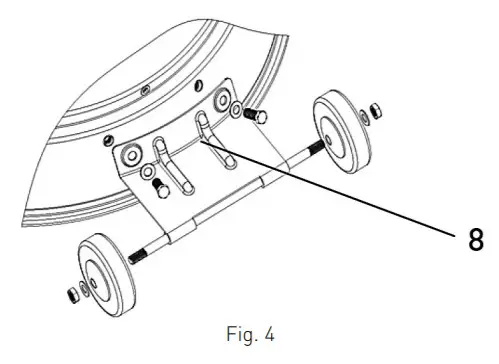 |
Optional base stand
Base stand assembly parts: 6pcs bolts M5 x 12 and 6pcs washers for base stands and base.
Attach 3pcs stands to the base. Buy suitable hook bolts or rawlbolts from your local market to insert them into the ground or floor through base stand holes for this appliance’s stability. (See Figure 3)

Optional wheels
Wheels assembly parts: 2pcs bolts, 4pcs washers, and 2pcs nuts for wheels assembly. Collect wheels parts together and fix wheels to the base. (See Figure 4)
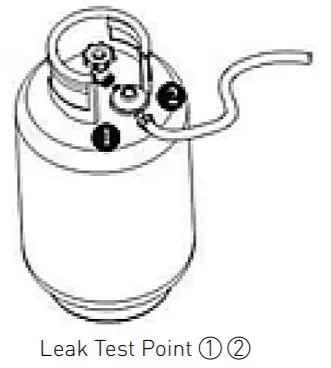
Operating instructions
Before first use and after every gas cylinder change, the gas delivery system must be purged of air before igniting!
To do this, turn the control knob counter-clockwise to the pilot setting. Press knob in and hold for 3 minutes before attempting ignition.
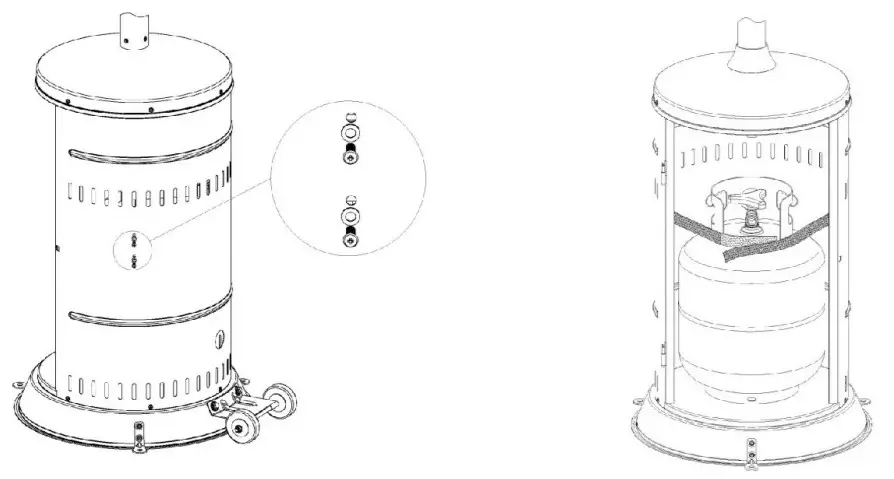
To light the pilot
- Check all connections prior to each use.
- Turn on the main gas supply.
- Press to turn control knob counter-clockwise to PILOT, see right photo.
- Hold knob depressed, press IGNITION button repeatedly until pilot flame is lit, then continue to hold the knob depressed for 10 seconds until the pilot remains it after releasing knob.
- If the pilot fails to ignite or alight, press to turn the knob clockwise to OFF and repeat.
To light the patio heater
- The pilot should be lit and the knob set to PILOT.
- Press the knob 3mm and turn anti-clockwise to HIGH.
- When mesh glows lit, turn the knob clockwise from HIGH to LOW as needed.
Note: The burner may be noisy when initially turned on. To eliminate excessive noise from the burner, turn the control knob to the pilot position. Then, turn the knob to the level of heat desired.
Re-lighting
Note: For your safety, Control Knob cannot be turned OFF without first depressing Control Knob in PILOT position and then rotating it to OFF.
- Turn Control Knob to OFF.
- Wait at least 5 minutes, to let the gas dissipate, before attempting to re-light the pilot.
- Repeat the “Lighting” steps
To extinguish
- Hold knob depressed & turn the knob clockwise to ‘OFF’
- Close the valve of the gas cylinder or the regulator after use.
- Allow this appliance to cool before moving.
Note: After use, some discoloration of the emitter screen is normal.
Leak testing
NEVER USE A NAKED FLAME TO CHECK FOR LEAKS. NEVER LEAK TEST WHILE SMOKING
The gas connections on this appliance are leak tested at the factory prior to shipment. This appliance needs to be periodically checked for leaks and an immediate check is required if the smell of gas is detected.
- Make a soap solution using 1 part of liquid dish-washing soap to 3 parts water. The soap solution can be applied with a soap bottle, brush, or rag to the leak-tested points shown in the figure above.
- The valve of the gas cylinder should be in the OFF position at this point of the leak test. Once the soapy solution is applied to the gas connections, the valve of the gas cylinder needs to be turned to the ON position.
- Soap bubbles will begin to form in the soapy solution if a leak is present.
- In case of a leak, turn off the gas supply. Tighten any leaking fittings, then turn the gas supply on and recheck.
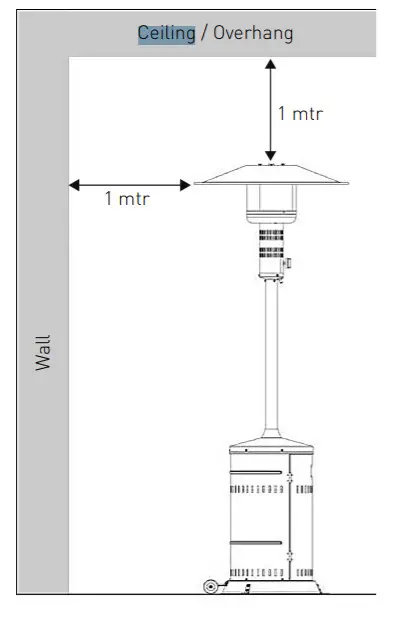
Gas requirements
- The pressure regulator and hose assembly to be used must conform to local standard codes.
- Never use a gas cylinder with a damaged body, valve, collar, or foot ring.
- A dented or rusty gas tank may be hazardous and should be checked out by a gas supplier.
- Never connect this appliance to an unregulated gas source.
- When the appliance is not in use, turn the gas cylinder OFF.
- Always perform a leak test on gas connections whenever a cylinder is connected. If bubbles form in the leak test solution, do not use it. Never use a flame to test for leaks.
Connecting to a gas cylinder
- Recommend to use a 9kg gas cylinder or refer to your gas supplier for suitable gas cylinders.
- The approved gas regulator is used according to appliances categories and countries listed in the data plate. The approved flexible hose would be changed when the national conditions require it & consult the local regulations, these may differ.
- Warning: assembly of the tubing must be conducted by some qualified tuber of destination countries.
- Refer to your gas supplier for instructions on the use of your gas cylinder.
- Only change gas cylinders outdoors or in a well-ventilated area away from naked flames and any other source of ignition.
- The gas cylinder must always be used in an upright position.
- Close the heater control knob by turning fully clockwise.
- Close the gas cylinder tap and then attach the regulator onto the gas cylinder.
- Tighten all connections firmly and with a spanner where appropriate. The cylinder should be located on the cylinder base.
- The gas cylinder must be fixed by the cylinder belt, which is inside the housing, while installation.
- Check for leaks at all joints using soapy water. If a leak is found, tighten the joint and then re-test.
Securing the gas cylinder
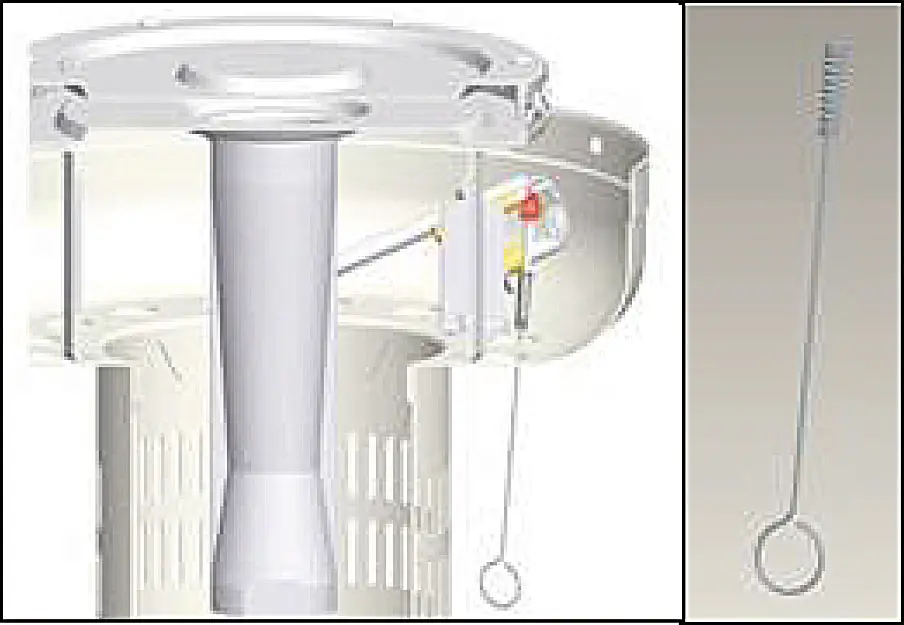
- Fix both brackets of Velcro tapes onto the base using 4pcs M6*12 bolts, M6 washer, and M6nuts.
- Position a gas cylinder inside the tank housing.
- Connect the gas cylinder with a regulator. Please refer to the instructions attached with the regulator on how to connect a regulator with the gas cylinder.
- Stick Velcro tapes together as the above photo illustrated. The tapes must be in a proper tightness for the gas cylinder.
Caution: Please take care that the Velcro tapes. DO NOT strain the regulator assembly.
Important safety rules

For use outdoors or in amply ventilated areas. An amply ventilated area must have a minimum of 25% of the surface area open.
The surface area is the sum of the surface of the wall.
The use of this appliance in enclosed areas can be dangerous and is PROHIBITED.
Children and adults should be aware of the high operating temperatures of areas above the post when operating this heater. Children should be carefully supervised when in the vicinity of the heater.
NEVER hang anything, including clothes or any other flammable items, on this heater.
DO NOT operate this heater unless it is fully assembled ith its reflector in place. Respect the minimum clearances from combustible materials.
The length of the gas hose may not exceed 1,5 meters.
Maintenance
To enjoy years of outstanding performance from your heater, make sure you perform the following maintenance activities on a regular basis:
- Keep exterior surfaces clean.
- Use warm soapy water for cleaning. Never use flammable or corrosive cleaning agents.
- While washing your unit, be sure to keep the area around the burner and pilot assembly dry at all times. If the gas control is exposed to water in
any way, DO NOT try to use it. It must be replaced. - Airflow must be unobstructed. Keep controls, burner, and circulation air passageways clean. Signs of possible blockage include:
- Gas odor with extreme yellow tipping of flame.
- The heater does NOT reach the desired temperature.
- The heater glow is excessively uneven.
- The heater makes popping noises.
- Spiders and insects can nest in burner or orifices.
This dangerous condition can damage the heater and render it unsafe for use. Clean burner holes by using a heavy-duty pipe cleaner. Compressed air may help clear away smaller particles. - Carbon deposits may create a fire hazard. If any carbon deposits develop, clean the dome and engine with warm soapy water.
Note: in a salt-air environment (such as near the sea), corrosion occurs more quickly than normal. Frequently check the corroded areas and repair them promptly.
Servicing
- Please consult your local dealer for servicing this appliance and replacement of its parts. The servicing of the appliance shall be carried out only by authorised personnel.
- Caution: do not use unauthorized parts or components for this appliance, only use original equipment replacement parts and components. The use of unauthorized parts or components will void the warranty and can create an unsafe condition.
Storage
Between uses:
Turn control knob OFF
Turn gas cylinder OFF
Store the Heater upright in an area sheltered from direct contact with inclement weather (such as rain, sleet, hail, snow, dust and debris).
If desired, cover to protect exterior surfaces and to prevent build-up in air passages.
Note: Wait until the heater is cool before covering.
During periods of extended inactivity or when transporting:
Turn control knob OFF.
Disconnect gas cylinder and move to a secure, well-ventilated location outdoors. DO NOT store in a location that will exceed 50°C. Store heater right in an area sheltered from direct contact with inclement weather (such as rain, sleet, hail, snow, dust, and debris).
If desired, cover the heater to protect exterior surfaces and to prevent build-up in air passages.
Note: Wait until the heater is cool before covering
CAUTION: DO NOT USE UNAUTHORISED PARTS OR COMPONENTS FOR THIS APPLIANCE. ONLY USE ORIGINAL EQUIPMENT REPLACEMENT PARTS AND COMPONENTS.
To retract the heater (272701 only)
Retracting the heater makes storage much easier. Loose the plastic screw (17) properly. Pull up the main post vertically until it encounters the housing lid. Turn the main post clockwise and lower it until it has reached the desired level. To lock the main post on the desired level pull up the main post just
a little and turn it counterclockwise. Then lower it until the main post stands on its screws. Tighten the plastic screw to keep the heater stable.
Note: Mind your head. Wait until the heater is cool before retracting.
Troubleshooting
| PROBLEM | AND THIS CONDITION EXISTS | THEN DO THIS |
| Pilot won’t light | The cylinder valve is closed | Open valve |
| Blockage in orifice or pilot tube | Clean or replace orifice or pilot tube. | |
| Air in the gas line | Open gas tine and bleed it (pressing control knob in) for not more than 1-2 minutes or until you smell gas. | |
| Low gas pressure | Replace propane gas (disposable) cylinder with a new cylinder | |
| Igniter fails | Use a match to light pilot (with match holder, see picture•); obtain new igniter and replace | |
| The pilot won’t stay lit | Dirt build-up around pilot | Clean dirt from around pilot |
| The connection between gas valve and pilot assembly is loose | Tighten connection and perform a leak test | |
| The thermocouple is not operating correctly | Replace thermocouple | |
| Burner won’t tight | Gas pressure is low | Replace propane gas (disposable) cylinder with a new cylinder |
| Blockage in orifice | Clear blockage | |
| The control knob is not in the “ON” position | Turn the control knob to “ON” position | |
| The burner flame is low Note: Do not operate heater below 5°C (40°F) |
Gas pressure is low | Replace propane gas (disposable) cylinder with a new cylinder |
| Outdoor temperature is greater than 406F and tank is less than 25% full | Replace propane gas (disposable) cylinder with a new cylinder | |
| The supply hose is bent or kinked | Straighten hose and perform leak test on the hose | |
| The control knob is full ” ON” | Turn the control knob to ” OFF”, let cool to room temperature, and check burner and orifices for blockage | |
| Emitter glows uneven Note: Bottom 1 inch of emitter normally does not glow |
Gas pressure is low | Replace propane gas (disposable) cylinder with a new cylinder |
| The base is not on a level surface | Place heater on a level surface | |
| Heater is level | Clean burner | |
| Carbon build-up | Dirt or film on reflector and emitter | Clean reflector and emitter |
| Thick black smoke | Blockage in burner | Turn the control knob to “OFF”, let cool to room temperature and remove blockage, and clean the burner inside and outside. |

If for some reasons your ignition fails to deliver a spark, the heater can be started by inserting a lit match using supplied match holder through the burner hole (see left photo) while pushing the control knob in the “PILOT” position.
IN THE EVENT OF ANY PROBLEM, PLEASE ALWAYS CONSULT YOUR LOCAL DEALER.
Warranty
Any defect affecting the functionality of the appliance which becomes apparent within one year after purchase will be repaired by free repair or replacement provided the appliance has been used and maintained in accordance with the instructions and has not been abused or misused in any way. Your statutory rights are not affected. If the appliance is claimed under warranty, a state where and when it was purchased and include proof of purchase (e.g. receipt).
In line with our policy of continuous product development, we reserve the right to change the product, packaging, and documentation specifications
without notice.
Discarding & Environment
When decommissioning the appliance, the product must not be disposed of with other household waste. Instead, it is your responsibility to dispose to your waste equipment by handing it over to a designated collection point. Failure to follow this rule may be penalized in accordance with applicable regulations on waste disposal. The separate collection and recycling of your waste equipment at the time of disposal will help conserve natural resources and ensure that it is recycled in a manner that protects human health and the environment. For more information about where you an drop off your waste for recycling, please contact your local waste collection company. The manufacturers and importers do not take responsibility or recycling, treatment, and ecological disposal, either directly or through a public system.

Hendi B.V.
Innovatielaan 6
6745 XW De Klomp, The Netherlands
Tel: +31 317 681 040
Email: [email protected]
PKS Hendi South East Europe SA
5 Metsovou Str. 18346 Moschato, Athens, Greece
Tel: +30 210 4839700
Email: [email protected]
Find Hendi on internet:
www.hendi.eu
www.facebook.com/HendiToolsforChefs
www.linkedin.com/company/hendi-food-service-equipment-b.v.
www.youtube.com/HendiEquipment
– Changes, printing and typesetting errors reserved.
© 2021 Hendi B.V. De Klomp – The Netherlands
from the actual model
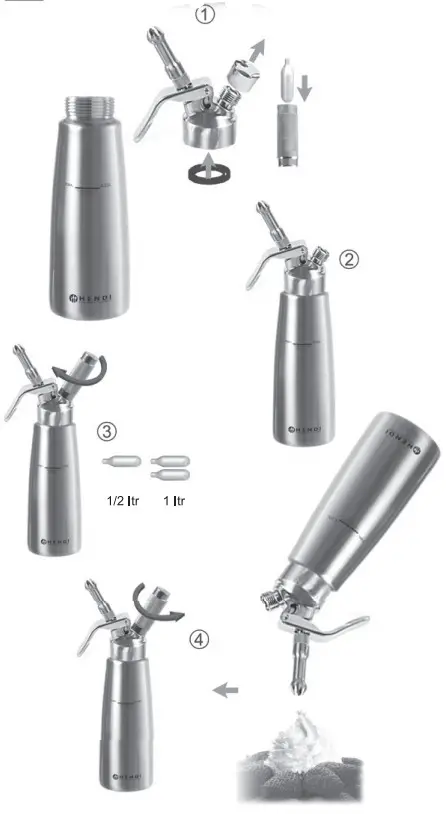

Thank you for choosing this versatile and high-quality HENDI Cream Whipper. With this universal kitchen tool, you can create a multitude of light desserts, creams, sweet and sour mousses as well as sauces. Some kinds of liquid ingredients, such as juices, coffee, chocolate syrup, vanilla cream, yogurt, etc. can be used in HENDI Cream Whipper, but only if they contain no insoluble substances!
For guaranteed quality, please use HENDI cream chargers only. Please read the instructions thoroughly before using them the first time!
SAFETY INSTRUCTIONS
 If the warnings included in the manual next to this symbol are not observed, injuries of operating personnel and third persons, as well as whipper or other property damage, may
If the warnings included in the manual next to this symbol are not observed, injuries of operating personnel and third persons, as well as whipper or other property damage, may
occur.
The manufacturer and the distributor shall not be liable for damage resulting from failure to observe the manual.
WARNING – HIGH PRESSURE
The filled whipper and cartridges are pressurized. Opening of the filled whipper partly filled whipper, and/or piercing of the full or empty cartridge is forbidden – the risk of explosion.
- Please keep this instruction booklet for later reference to avoid any improper handling or operating. This whipper is designed exclusively for the purposes specified in this manual.
- The whipper and the charger are pressure containers that require increased attention and care.
- For the chargers, pertinent safety instructions are given on its package.
- Keep HENDI Cream Whipper and chargers out of the reach of children.
- For safety reasons do not bend over the whipper nor lean over the whipper when screwing in the charger! Remark that the cream maker head has to be firmly screwed on before the cream maker can be taken into operation with the charger.
- HENDI head screws easily onto the bottle in an upright position. Do not cross-thread.
- All HENDI parts can be assembled easily; therefore never use force.
- Never use the whipper if damaged. HENDI Cream Whipper which has been dropped should be checked by HENDI before resuming use.
- Press the lever until the hissing sound stops before opening HENDI Cream Whipper when gas has completely escaped.
- Do not expose HENDI Cream Whipper to heat (stove, sunlight, oven, microwave, etc.).
- Please be advised that tampering with the whipper and/or its components voids any and all warranties of the manufacture/supplier.
- The contents may not be warmer than 75°C.
(see illustrations)
 If the warnings included in the manual next to this symbol are not observed, injuries of operating personnel and third persons, as well as whipper or other property damage, may occur.
If the warnings included in the manual next to this symbol are not observed, injuries of operating personnel and third persons, as well as whipper or other property damage, may occur.
The manufacturer and the distributor shall not be liable for damage resulting from failure to observe the manual.
- When using your whipper for the first time, or if you have not used it for a while, rinse the bottle first with lukewarm water, then with cold water before filling it with cream.
- Fill with well-chilled fresh cream or well mixed and strained liquid ingredients (fig. 1). Never exceed the maximum filling quantity engraved on the outside of the bottle maximum one pint/0.5 liter for 0.5 L bottle or maximum one quart/1 liter or 1.0 L bottle). If you want to sweeten your cream, we recommend using sugar syrup. If using sugar or cream stiffener, stir and dissolve it irst completely into a little cream to avoid the formation of lumps.
 WARNING – HIGH PRESSURE
WARNING – HIGH PRESSURE
The 0.5 l whipper shall be filled with 0.5 l of cream and only one cartridge.
The 1.0 l whipper shall be filled with 1.0 l of cream and two cartridges.
ANY OTHER CREAM VOLUMES AND CARTRIDGE NUMBERS ARE FORBIDDEN – the risk of explosion. - Ensure that the head gasket is positioned correctly and firmly in the head (fig.1). Then place the head on the bottle and screw closed as follows: Turn the head clockwise until you feel resistance, then turn a further quarter of a turn. Do not cross-thread! (fig. 2).
 WARNING – RISK OF EXPLOSION
WARNING – RISK OF EXPLOSION
Make sure that the head gasket is properly seated and that it is not damaged. ONLY ORIGINAL GASKETS CAN BE USED!
Make sure that the threads on the whipper head and bottle are not damaged.
USE OF THE WHIPPER HEAD/BOTTLE WITH DAMAGED THREAD IS FORBIDDEN. - Insert the silver-colored HENDI cream charger (N2 O) into the charger holder as illustrated (fig. 1).
- Screw the charger holder and charger onto the inlet valve until the gas is released into the bottle with a hissing sound (fig. 3). Use 1 charger per filling (2 chargers with 1 quart/liter bottle). Shake the whipper briskly 4~5 times in a vertical direction. When using well-cooled light cream or other mixtures, shake up to ten times. Unscrew the charger holder and charger (fig. 4). The slight hissing sound while unscrewing is normal. Remove and discard the used charger. HINDI chargers are made from high grade steel and can be recycled.
 WARNING – RISK OF EXPLOSION
WARNING – RISK OF EXPLOSION
Make sure that the head gasket is properly seated and that it is not damaged. ONLY ORIGINAL GASKETS CAN BE USED!
WARNING.
If an empty cartridge is left in the holder screwed on the head, the piston gasket will be damaged. Always unscrew the holder with the empty cartridge immediately after filling the whipper with gas. - To dispense the content, hold the whipper vertically (decorating nozzle pointing downward) about 1 cm above the surface. Then press the lever lightly (fig. 4). If whipped cream is not firm enough, shake it once more. When using later, do not shake again. Keep filled cream whipper in the refrigerator but never in the deep-freezing compartment or in the freezer. Before placing the whipper-in the refrigerator, remove the decorating nozzle from the nozzle adaptor, rinse with lukewarm water and replace. The content will stay fresh for several days in the refrigerator.
IMPORTANT DIRECTIONS
Mind the following important points:
- To get a better result, please cool the whipper well under cold water or in the refrigerator before filling.
- Only use soluble ingredients. For sweetening, it is best to use sugar syrup or liquid sweeteners. Granulated sugar or salt should first be dissolved in cool water or cream. Use powdered or liquid spices only. Insoluble substances such as seeds, pulp, etc. prevent the closure of the dispensing piston or might impair the proper functioning of the whipper. If you use blended mixtures, please use a fine strainer o remove seeds or pulp.
- The HENDI Cream Whipper is well suited for the preparation of cold mousses, (hot) sauces, or Espumas.
- Excessive shaking may stiffen pure cream to a degree that it loses its soft texture, therefore please do not overshake! Do not shake every time before dispensing. Please
shake recipes consisting of mixtures of cream and other liquids well and more frequently. - When dispensing, always hold the whipper upside down (decorating nozzle pointing downward), otherwise gas will escape and some cream may remain inside the whipper.
- For best result, serve immediately upon dispensing.
- For spare parts, please contact your dealer or HENDI directly.
- Use only genuine HENDI Cream Whipper spare parts. Never combine parts with other HENDI products or other manufacturers’ products. HENDI components are identified by HENDI marks on the head, charger holder, and the bottom of the bottle.
- For repairs always return the entire unit (head plus bottle).
TROUBLESHOOTING
The charger is not pierced open:
An unsuitable charger has been used or the charger was inserted incorrectly. Use the exclusively disposable HENDI cream charger and place it in the charger holder as shown in Fig. 1.
You have not pressed the lever, nevertheless, cream flows from the nozzle and can’t be stopped:
a) Additives such as powdered sugar, cream stiffener, pulp, etc. have not been completely dissolved, blocking the piston. Turn the whipper into an upright position (nozzle up), place it on the countertop and wait until the content has settled on the bottom. Cover the nozzle well with a heavy towel and carefully press the lever to release gas until the hissing sound stops, then unscrew the head, clean the dispensing piston, strain contents and refill the whipper.
b)The dispensing piston is damaged. Send the appliance to HENDI or a service center.
When the charger is being screwed in, gas escapes between the bottle and the head:
a) The head gasket is missing. Insert a head gasket in the head.
b) The head gasket is damaged. Insert a new gasket.
c) The head is not screwed on firmly enough. Screw the head onto the bottle firmly in accordance with User Instructions.
d) The upper edge of the bottle is damaged. Send the appliance to HENDI or a service center.
The cream is still liquid after preparation:
a) The whipper was not shaken firmly or often enough. Shake again firmly.
b) The whipper was not turned upside down when pressing the lever. Always turn the whipper upside down before pressing the lever (decorating nozzle pointing vertically downward!)
The cream is too firm and “spits” sideways from the nozzle:
The whipper has been shaken too much. Do not over-shake nor shake before each dispensing.
IMPORTANT: Do not attempt to modify the whipper. If you cannot solve a problem with the help of these instructions, please contact HENDI or a service center.
Cleaning
Before opening, allow remaining pressure to escape by pressing the lever until no cream or gas is discharged through the nozzle. An insignificant amount of cream may remain in the bottle – a teaspoon of liquid cream at the most.
Follow steps 1, 2, and 3 to clean your HENDI Cream Whipper:
1. Unscrew the head then remove the head gasket and decorating the nozzle. Hold end of the piston inside the head while unscrewing the nozzle adaptor with the other hand.
2. Thoroughly clean each individual component with a mild detergent and a brush.
3. Allow the parts to dry and reassemble them later.
4. When cleaning, only remove parts as shown in fig. 5.
5. Do not use any sharp objects or abrasive materials when cleaning the bottle.
6. Both, bottle and head are dishwasher proof.
WARRANTY
Defective whipper (faulty materials or bad workmanship) will be repaired without charge (freight prepaid!) within twelve months of date of purchase per valid invoice. This warranty does not cover any liability for malfunction caused by improper use, use of damaged/wear parts, or any consequential damage. In order to assure the proper functioning of your cream whipper, only use original HENDI parts. In particular, we shall not satisfy any warranty or liability claims for malfunction, damage, and conseq ential
damage resulting from any failure of complying with and/or failure to read this manual and the safety instructions contained therein. For further information: visit us at www.hendi.eu
– Changes, printing, and typesetting errors reserved.
]]>270097

You should read this user manual carefully before using the appliance.

Technical specifications
| Article number | 270097 |
| Voltage | 220-240V / B |
| Power input | 13W |
| Frequency | 50 Hz / Iii |
| Current | 0.14 A |
| Exterior dimensions | 470x100x1H1263 mm/ MM |
| Ambient temperature | 10°C – 45°C |
| Relative humidity | 10-70°k RH |
| Protecion class | IPXO |
Dear Customer,
Thank you for purchasing this Hendi appliance. Before using the appliance for the first time, please read this manual carefully, paying particular attention to the safety regulations outlined below.
Safety regulations
- This appliance is intended for commercial use only and must not be used for household use.
- The appliance must only be used for the purpose for which it was intended and designed.
The manufacturer is not liable for any damage caused by incorrect operation and improper use. - Keep the appliance and electrical plug away from water and any other liquids. In the vent that the appliance should fall into the water, immediately remove the plug from the socket
and do not use until the appliance has been checked by a certified technician. Failure to follow these instructions could cause a risk to lives. - Never attempt to open the casing of the appliance yourself.
- Do not insert any objects in the casing of the appliance.
- Do not touch the plug with wet or damp hands.
- Danger of electric shock! Do not attempt to repair the appliance yourself. In case of malfunctions, repairs are to be conducted by qualified personnel only.
- Never use a damaged appliance! Disconnect the appliance from the electrical outlet and contact the retailer if it is damaged.
- Warning! Do not immerse the electrical parts of the appliance in water or other liquids.
Never hold the appliance under running water. - Regularly check the power plug and cord for any damage. If the power plug or power cord is damaged, it must be replaced by a service agent or similarly qualified persons in order to avoid danger or injury.
- Make sure the cord does not come in contact with sharp or hot objects and keep it away from an open fire. To pull the plug out of the socket, always pull on the plug and not on the cord.
- Ensure that the cord (or extension cord) is positioned so that it will not cause a trip hazard.
- Always keep an eye on the appliance when in use.
- Warning! As long as the plug is in the socket the appliance is connected to the power source.
- Turn off the appliance before pulling the plug out of the socket.
- Never carry the appliance by the cord.
- Do not use any extra devices that are not supplied along with the appliance.
- Only connect the appliance to an electrical outlet with the voltage and frequency mentioned on the appliance label.
- Connect the power plug to an easily accessible electrical outlet so that in case of emergency the appliance can be unplugged immediately. To completely switch off the appliance pull the power plug out of the electrical outlet.
- Always turn the appliance off before disconnecting the plug.
- Never use accessories other than those recommended by the manufacturer. Failure to do so could pose a safety risk to the user and could damage the appliance. Only use original parts and accessories.
- This appliance is not intended for use by persons (including children) with reduced physical, sensory or mental capabilities, or lack of experience and knowledge.
- This appliance must not be used by children under any circumstances.
- Keep the appliance and its cord out of reach of children.
- Always disconnect the appliance from the mains if it is left unattended or is not in use, and before assembly, disassembly or cleaning.
- Never leave the appliance unattended during use.
Special safety regulations
Note!! This appliance uses high voltage (more than 1000 Volt). Never touch the high-voltage grids. During cleaning and/or maintenance ALWAYS remove the plug from the socket and discharge the appliance afterward (discharge by short-circuiting the high-voltage grids with a metal object with an isolated grip). Do not use near flammable liquids or gases. DANGER OF EXPLOSION!
Intended use
- This appliance is designed solely for attracting and electrocuting flies and other insects. Any other use may lead to damage of the appliance or personal injury.
- Operating the appliance for any other purpose shall be deemed a misuse of the device. The user shall be solely liable for improper use of the device.
User instructions
Position the appliance as indicated at “Best place for fixing”. Put the plug into the socket. The fluorescent tube should fight now. After some time the rawer of the Electronic Fly Trap will become full and should be emptied. Remove the plug from the socket and remove the drawer (fig.8) to empty it. Suitable for a room with an area of 300m2 maximum.
In the packing, you will find the following parts
- The appliance is complete with tubes and drawer
- A chain to hang the appliance
- The user manual
Best place for fixing
- Away from windows or doors because of draft and daylight.
- Away from places where food will be prepared or presented.
- Close to the area where flies come in but away from draft and wind.
- Somewhere the appliance can stay 24 hours a day.
- Above eye level and so that no one can bump the appliance.
- Out of reach from flammable objects like curtains, lace curtains, etc.
- Away from flammable liquids or gases. DANGER OF EXPLOSION
- This appliance can stand as well as hang by the included chain
Preparations before using for the first time
- Check to make sure the appliance is undamaged.
In case of any damage, contact your supplier immediately and do NOT use the appliance. - Remove all the packing material and protection film (if applicable).
- Clean the appliance with lukewarm water and a soft cloth.
- Place the appliance on a level and steady surface, unless mentioned otherwise.
- Make sure there is enough clearance around the appliance for ventilation purposes.
- Position the appliance in such a way that the plug is accessible at all times.
Cleaning and maintenance
- Always remove the plug from the socket before cleaning the appliance.
- Beware: Never immerse the appliance in water or any other liquid!
- Clean the outside of the appliance with a damp cloth (water with mild detergent).
- Never use aggressive cleaning agents or abrasives.
Do not use any sharp or pointed objects. Do not use petrol or solvents! Clean with a damp cloth and detergent if necessary. Do not use abrasive materials. - Clean the ventilation slots (if applicable) with the vacuum cleaner.
Warranty
Any defect affecting the functionality of the appliance that becomes apparent within one year after purchase will be repaired by free repair or replacement provided the appliance has been used and maintained in accordance with the instructions and has not been abused or misused in any way. Your statutory rights are not affected. If the appliance is claimed under warranty, state where and when it was purchased and include proof of purchase (e.g. receipt). In line with our policy of continuous product development, we reserve the right to change the product, packaging, and documentation specifications without notice.
Discarding & Environment
When decommissioning the appliance, the product must not be disposed of with other household waste. Instead, it is your responsibility to dispose to your waste equipment by anding it over to a designated collection point. Failure to follow this rule may be penalized in accordance with applicable regulations on waste disposal. The separate collection and recycling of your waste equipment at the time of disposal will help conserve natural re- sources and ensure that it is recycled in a manner that protects human health and the environment.
For more information about where you can drop off your waste for recycling, please contact your local waste collection company. The manufacturers and importers do not take responsibility for recycling, treatment, and ecological disposal, either directly or through a public system.

| Hendi B.V. Steenoven 21 3911 TX Rhenen, The Netherlands Tel: +31 (0)317 681 040 Email: [email protected] |
Hendi Food Service Equipment Romania Srl Str. 13 decembrie 94A, Hala 14 Brașov, 500164, Romania Tel: +40 268 320330 Email: [email protected] |
Changes, printing and typesetting errors reserved.
© 2019 Hendi BV Rhenen – The Netherlands
Ver: 02-04-2020
HENDI Heavy Duty Planetary Mixer
You should read this user manual carefully before using the appliance.
Dear Customer,
Thank you for purchasing this Hendi appliance. Before using the appliance for the first time, please read this manual carefully, paying particular attention to the safety regulations outlined below.
Safety regulations
- This appliance is not intended for household use.
- The appliance must only be used for the purpose for which it was intended and designed. The manufacturer is not liable for any damage caused by incorrect operation and improper use.
- Keep the appliance and electrical plug away from water and any other liquids. In the event that the appliance should fall into water, immediately remove plug from the socket and do not use until the appliance has been checked by a certified technician. Failure to follow these instructions could cause a risk to lives.
- Never attempt to open the casing of the appliance yourself.
- Do not insert any objects in the casing of the appliance.
- Do not touch the plug with wet or damp hands.
- Danger of electric shock! Do not attempt to repair the appliance yourself. In case of malfunctions, repairs are to be conducted by qualified personnel only.
- Never use a damaged appliance! Disconnect the appliance from the electrical outlet and contact the retailer if it is damaged
- Warning! Do not immerse the electrical parts of the appliance in water or other liquids. Never hold the appliance under running water.
- Regularly check the power plug and cord for any damage. If the power plug or power cord is damaged, it must be replaced by a service agent or similarly qualified persons in order to avoid danger or injury.
- Make sure the cord does not come in contact with sharp or hot objects and keep it away from open fire. To pull the plug out of the socket, always pull on the plug and not on the cord.
- Ensure that the cord (or extension cord) is positioned so that it will not cause a trip hazard.
- Always keep an eye on the appliance when in use.
- Warning! As long as the plug is in the socket the appliance is connected to the power source.
- Turn off the appliance before pulling the plug out of the socket.
- Never carry the appliance by the cord.
- Do not use any extra devices that are not supplied along with the appliance.
- Only connect the appliance to an electrical outlet with the voltage and frequency mentioned on the appliance label.
- Connect the power plug to an easily accessible electrical outlet so that in case of emergency the appliance can be unplugged immediately. To completely switch off the appliance pull the power plug out of the electrical outlet.
- Always turn the appliance off before disconnecting the plug.
- Never use accessories other than those recommended by the manufacturer. Failure to do so could pose a safety risk to the user and could damage the appliance. Only use original parts and accessories.
- This appliance is not intended for use by persons (including children) with reduced physical, sensory or mental capabilities, or lack of experience and knowledge.
- This appliance must not be used by children under any circumstances.
- Keep the appliance and its cord out of reach of children.
- Always disconnect the appliance from the mains if it is left unattended or is not in use, and before assembly, disassembly or cleaning.
- Never leave the appliance unattended during use.
Special Safety Regulations
- Use the machine only as described in this manual.
- This machine should be operated and installed by specialized trained personnel in the kitchen of the food industry such as catering, bakery, pizza, pastry, etc.
- All maintenance, installation and repair works should be performed by specialized trained authorized technicians.
- An equipotential bonding terminal is provided at the rear side of the appliance to allow cross bonding with other equipment.
- Do not place the machine on a heating object (gasoline, electric, charcoal cooker, etc.) Keep the appliance away from any hot surfaces and open flames. Always operate the machine on a level, stable, clean, heat-resistant and dry surface.
- Do not use the machine near explosive or flammable materials, credit cards, magnetic discs or radios.
- Wear protective clothing, mask, or protective glasses if necessary during operation.
- This machine is not intended to be operated by means of an external timer or separate remote-control system.
- Never bypass any safety interlocks on the machine.
- WARNING: Keep all ventilation openings in the appliance clear of obstruction.
- WARNING: ALWAYS switch off the machine and unplug from electrical power supply before cleaning, maintenance or changing attachments.
- Allow at least 30 cm spacing around the appliance for ventilation purpose during use.
- Caution! Securely route the power cord if necessary in order to prevent unintentional pulling or contact with the heating surface.
- WARNING! ALWAYS keep hands, long hair and loose clothing away from the moving parts.
- Do not put hands into the guarded area and mixing bowl when the machine is in operation.
- Do not load too much ingredients in order to prevent overflow of the food products. Maxi-mum capacity of the bowl is 10 liters for 222836, 222966 and 20 liters for 222843, 222973.
- Do not wash the machine with water or a waterjet. Washing with water can cause leakage and increase the risk of electric shock. No parts are dishwasher safe.
- Do not clean or store the machine unless it is completely cooled down.
- Special care should be taken when moving or transporting the machine as it is too heavy. With at least 2 people or using a trolley for assistance. Move the machine slowly, carefully and never be inclined over 45°C.
Intended use
- The appliance is intended for professional use and can be operated only by qualified personnel.
- The appliance is designed for mixing, kneading and emulsifying/whipping food products (e.g. flour, sugar, oils, fat, eggs and other ingredients) operated in the food industry and shops (e.g. catering, bakery, pizza, pastry and confectionary industry). Any other use may lead to damage to the appliance or personal injury.
- Operating the appliance for any other purpose shall be deemed as a misuse of the device. The user shall be solely liable for improper use of the device.
Grounding installation
This appliance is classified as protection class I appliance and must be connected to a protective ground. Grounding reduces the risk of electric shock by providing an escape wire for the electric current. This appliance is equipped with a cord having a grounding wire with a grounding plug. The plug must be plugged into an outlet that is properly installed and grounded.
Main parts of the machine
- Rigid stand support
- Bowl
- Bowl clamp (x2)
- Bowl handles (x2)
- Bowl guard
- Speed control lever (3 settings for 3 attachments)
- ON button (GREEN, I)
- STOP button (RED, O)
- Bowl lift / lower handle
- RESET button (at the rear)
- Bowl guard handle
- Bowl cradle
Attachments
Preparations before installation
- Carefully unbolt the machine from the skid using wrench if necessary.
- Remove all protective packaging and wrapping.
- Check the machine for completeness and trans-port damages. In case of incomplete delivery (e.g. Whisk, flat beater and dough hook) or damage, contact supplier immediately. DO NOT use the machine. (See ==> Warranty).
- Clean the machine and attachments before use (See ==> Cleaning and Maintenance).
- Make sure the appliance is completely dry.
Installation
- Read this manual thoroughly and carefully before installation and operation.
- Ensure the machine is placed in a dry area that have sufficient strength surface to support with no any obstruction during operation nearby.
- Ensure that the electrical power supply corresponds with the rating label on the machine.
- There should have adequate space around the machine for the operator to operate. It should be clean and free from obstructions, e.g. Nothing placed on or around the machine, such as scrap-ers, knives etc.
- Do not wear loose fitting clothing such as scarf, etc and long hair should be tied up and keep away from the moving parts.
CAUTION! Never bypass any safety switch.
Transportation and handling
- Do not move the machine while it is under operation.
- Unplug the machine, remove the bowl (2) and all attachments (whisk, flat beater or dough hook) when moving the machine.
- Hold the base of the machine (1) when moving to have better support.
- With at least 2 people or using trolley for assistance to move the machine due to heavy weight.
Special safety features
Attention: This machine has the following 3 safety switches. The machine only be started with all the safety switches are at the proper positions.
- Bowl position safety switch: The machine can be started up once the bowl is positioned at the correct position.
- Bowl guard (5) safety switch: The machine can only be started up once the bowl guard (5) is in the closed position.
- Bowl lift up handle (9) safety switch: The machine can only be started up once the bowl lift up han-dle (9) is located in the upwards position.
- Do not wear loose fitting clothing such as scarf, etc and long hair should be tied up and keep away from the moving parts
Operation
To avoid serious personal injury:
- DO NOT operate the machine without reading the instruction manual.
- ALWAYS STOP the machine by pressing RED “O” button (8) and unplug from electrical power supply before cleaning, maintenance, repair or changing any attachments.
- ALWAYS keep hands, hair and loose clothing away from the moving parts.
a) About the bowl guard
Note: When bowl guard (5) is open or not properly closed in lock position, the machine will not operate.
- To open the bowl guard (5), hold the bowl guard handle (11) and rotate it clockwise. To close the bowl guard (5), hold the bowl guard handle (11) and rotate it anti-clockwise.
- When the bowl guard handle (11) is lined up at the right side of the machine, the bowl guard (5) is in the is in the rocked position and ready for operation.
b) Install the bowl (2) to the machine
Note: Install the bowl (2) BEFORE fixing the attachments. Use the supplied bowl (2) only.
- Lower the bowl by pulling the bowl lift-up lever (9) downwards until it stops. So that the bowl cradle (12) is in a lower position.
- Place the bowl (2) carefully and slowly using the bowl handles (4) at 2 sides and
- With the locking pin into the hole at the middle of the bowl cradle (12) and
- Secure the bowl (2) by pull each bowl clamp (3) forward until the bowl (2) is locked tight.
c) Install different attachments (Flat beater, Dough hook or Whisk) to the machine
Note: It is more convenient and easier to install the attachments prior to adding the ingredients into the bowl (2).
- Rotate the bowl guard (5) clockwise gently with the bowl guard handle (6), so that it is in the open position.
- CAUTION! Use excessive force to open or close the bowl guard (5) may damage the safety lock micro switch. Be careful when open or close the bowl guard (5).
- Slide the attachments (Flat beater, Dough hook or Whisk) slowly upwards onto the planetary shaft fitting the shaft pin through the slot in the attachments.
- Rotate the attachments to secure it onto the planetary shaft.
d) Pouring and mixing ingredients
Note: Follow the “Mixing ingredients capacity” table in this manual. Overloading will lead to overflow or damage to the machine. IMPORTANT: Make sure the speed control lever (6) is set at the “dough hook” position.
- Add all the appropriate ingredients into the bowl (2).
- Lift upwards the bowl lift lever (9) until the bowl (2) locks into the position.
- Rotate the bowl guard (5) anti-clockwise and locks into the position.
e) Set the speed, attachment & start up the machine
- Select the appropriate speed by lifting or lowering the speed control lever (6). Three fixed speeds are available for different attachments
- After that, press the GREEN “I” button (7) to switch ON the machine. Press RED “O” button (8) to STOP the machine.
The machine will rotate in clockwise direction for item 222843 whereas and anti-clockwise direction for 222836. - CAUTION! ALWAYS STOP the machine BEFORE changing speeds. Failure to do so may damage the internal gear construction.
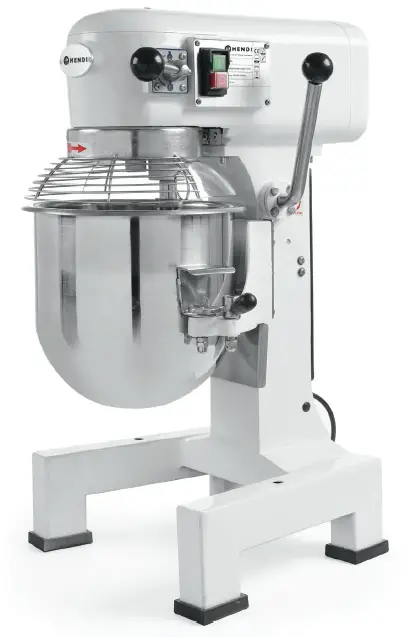
- To change the speed during the operation:
- Press the RED “O” button (8) to STOP the ma-chine.
- Unplug the machine and change the attachment. [See ==> part c)].
- Change the speed by raising or lowering the speed control lever (6) with the correct attachment.
- Press the GREEN “I” button (7) to restart the machine.
RESET the Hi-limiter (thermal cut-out)
Please note that the RESET button (10) is located at the rear of the machine in order to prevent overheated.
- Unplug the machine from the electrical power outlet first.
- Let the machine to cool down completely.
- Press the RESET button (10) of the Hi-limiter (thermal cut-out)
- Then, plug into the electrical power outlet and start up the machine again.
Mixing ingredients capacity
Below table is just a reference about the maximum quantity for making the different food. There are many factors affecting such as the type of the flour, temperature of water, etc.
| Product | Attachment | Max. quantity | |||
| 222836 | 222966 | 222843 | 222973 | ||
| Egg white | Whisk | 1,0 kg | 1,5 kg | ||
| Mashed potato | Flat beater | 2,0 kg | 2,5 kg | ||
| Meringue (Qty of water) | Whisk | 1,5 litre | 2,0 litre | ||
| Waffle or pancake batter | Flat beater | 2,5 litres | 3,0 litre | ||
| Whipped cream | Whisk | 3,5 litres | 4,0 litre | ||
| Pizza dough (Medium, 50% water) | Dough hook | 2,0 kg | 2,5 kg | ||
| Pizza dough (Thick, 60% water) | Dough hook | 2,5 kg | 3,0 kg | ||
| Sponge cake | Whisk | 1,5 kg | 2,0 kg | ||
| Pie Dough | Flat beater | 2,0 kg | 2,5 kg | ||
| Bread or Roll Dough (Light/ Medium, 60% water) | Dough hook | Water 1,5 kg/ Flour 2,5 kg | Water 3,0 kg/ Flour 5,0kg | ||
Cleaning and Maintenance
Attention: Always unplug the appliance from the electrical power outlet and let it cool down completely before cleaning, maintenance, repair & storage.
Cleaning
- Always remove all the attachments before easy cleaning, otherwise it will become stuck on the shaft and difficult to remove later.
- Clean the machine and its attachments thoroughly after each use and ensure all food residues are removed.
- Never immerse the appliance in water or other liquids.
- Clean the surface with a slightly damp cloth or sponge with some mild soap solution.
- Never use abrasive sponges, detergents, steel wool or metallic utensils to clean the interior or exterior parts of the appliance.
- DO NOT wash the appliance with water or water-jet. Washing with water can cause leakage and increase the risk of electric shock.
- No any parts or attachments are dishwasher safe.
Recommended cleaning procedure:
| Parts | How to clean | Frequency |
| Bowl | Using a sponge or damp cloth with mild soap and water, rinse, sanitize and dry thoroughly. | Clean after each use |
| Attachments (Dough hook, beater and whisk) | Hand wash using mild soap and wa- ter, rinse, sanitize and dry thoroughly. | Clean after each use |
| Bowl guard | Hand wash using a sponge or damp cloth with mild soap and water, rinse, sanitize and dry thoroughly. | Clean after each use |
| Outer surface | Wipe with a clean damp cloth using soap and water, rinse, sanitize and dry. Do not use water jet. | Twice a week |
| Planetary Shaft | Wipe with a clean damp cloth using soap and water, rinse, sanitize and dry. | Clean after each use |
Storage
- Before storage, always make sure the appliance has already been disconnected from the electrical outlet and cooled down completely.
- Store the appliance in a cool, clean and dry place.
Troubleshooting
If the machine does not function properly, please check the below table for the solution. If you are still unable to solve the problem, please contact the supplier/service provider. DO NOT repair yourself.
| Problems | Possible causes | Possible solution |
| Machine do not start running | Bowl guard (5) is not in properly closed position. | Rotate the bowl guard (5) to the right until ful- ly closed properly. |
| Bowl (2) is not raised to the proper location. | Raise the bowl (2) to the correct position by using the level (9). | |
| The power plug is not connected properly. | Check to make sure the power plug is con- nected properly. | |
| Machine stops during operation | Internal overload activates to prevent overheat. | Press RED, “O” button (8), unplug the ma- chine, leave for cook down completely, press RESET button (10) at the back. |
| Damage or broken transmission belt | Check with the supplier | |
| Machine sound too noisy | Machine is not placed on a horizontal surface. | Adjust the surface or move to another horizontal surface. |
| Bowl (2) is not placed correctly. | Make sure the bowl (2) is placed into the bowl cradle (12) correctly with the guided pins (3). | |
| Attachments not fitted properly. | Remove and install the attachments into po- sition again. | |
| Bowl is overloaded. | Reduce ingredients capacity. | |
| Damaged or worn transmission belt. | Check with the supplier. | |
| Planetary gear needs lack of lubricant. | ||
| Attachments cannot install onto the planetary shaft easily | Lack of lubricant and / or cleaning of the plane- tary shaft required. | Wipe planetary shaft with a clean damp cloth and lubricate the shaft with mineral oil or grease. |
| Bowl lift / lower handle (9) not operation easily | Lack of lubricant on the bowl slides. | Lubricate bowl slides with mineral oil or grease. |
Technical specification
| Item no. | 222836 | 222966 | 222843 | 222973 | |
| Operating voltage and frequency | 220 – 240 V~ 50/60Hz | ||||
| Rated input power | 600W | 1100W | |||
| Net weight (approx.) | 53kg | 78kg | |||
| Protection class | Class I | ||||
| Waterproof protection class | IP23 | ||||
|
Rotation speed (r.p.m.) |
Dough hook | 148 | 197 | ||
| Flat beater | 244 | 317 | |||
| Whisk | 480 | 462 | |||
| Maximum bowl capacity | 10L | 20L | |||
| Maximum amount flour mixing | 2,5 kg | 5,0 kg | |||
| Max noise level | < 70 dB (A) | ||||
| Outer dimension | 480 x 400 x (H) 630mm | 560 x 500 x (H) 880mm | |||
Remark: Technical specification is subjected to change without prior notification
Exploded drawing and part list
Attention: The exploded drawing and part list consists of below parts:
- Transmission gear system at the top, bowl cradle and stand (Figure 1);
- Axle assembly (Figure 2);
- Gear axle assembly (Figure 3);
- Motor assembly (Figure 4);
- Bowl lift up assembly (Figure 5);
- Bowl guard turning plate and mixing axle (Figure 6);
- Speed control assembly (Figure 7)
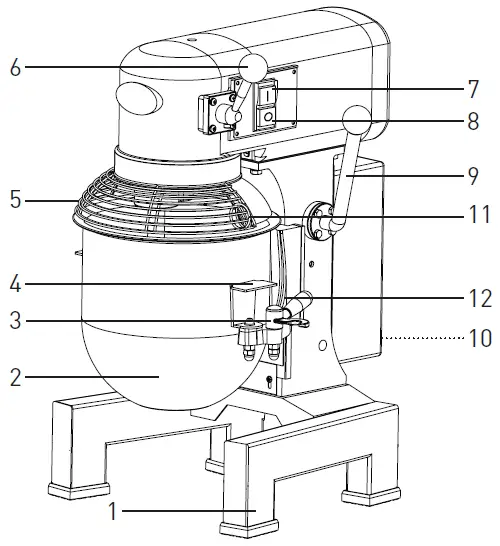
| Part no. | Part name | Quantity |
| 1 | Screw M5x35 | 1 |
| 2 | Top cover | 1 |
| 3 | Cover plate | 1 |
| 4 | Screw M5x12 | 5 |
| 5 | Bearing | 1 |
| 6 | Bearing | 1 |
| 7 | Bearing cover | 1 |
| 8 | Screw M5x20 | 4 |
| 9 | Main body part | 1 |
| 10 | Rear cover | 1 |
| 11 | Screw M6x55 | 4 |
| 12 | Ventilation cover | 1 |
| 13 | Screw M5x12 | 1 |
| 14 | Bowl cradle | 1 |
| 15 | Rigid stand | 1 |
| 16 | Capacitor board | 1 |
| 17 | Capacitor | 1 |
| 18 | Base | 1 |
| 19 | Safety covering switch | 1 |
| 20 | Fluctuate safety switch | 1 |
| 21 | Overload protection | 1 |
| 22 | PCB control board | 1 |
| 23 | AC contact devices | 2 |
| 24 | Reactor | 1 |
| 25 | Timer relay | 1 |

| Part no. | Part name | Quantity |
| 1 | Cover | 1 |
| 2 | Oil seal 25x40x10 | 1 |
| 3 | Bearing | 1 |
| 4 | Big joint gear | 1 |
| 5 | Bearing ring | 1 |
| 6 | Axle | 1 |
| 7 | Joint | 1 |
| 8 | Bearing ring | 1 |
| 9 | Joint gear | 1 |
| 10 | Washer | 1 |
| 11 | Engager | 1 |
| 12 | Spring | 8 |
| 13 | Roller | 4 |
| 14 | Ring gear | 1 |
| 15 | Ring plate | 1 |
| 16 | Bearing | 1 |

- Be sure to install correct position and lubricate all the pins in figure 2-1.
- Check if oil seal occur after reassembly.
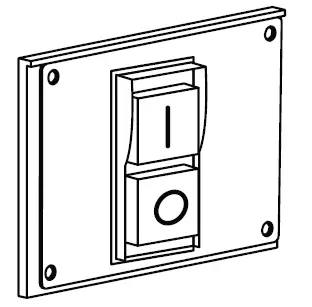
| Part no. | Part name | Quantity |
| 1 | Bearing | 2 |
| 2 | Gear axle | 1 |
| 3 | Key 5×58 | 1 |
| 4 | Gear | 1 |
| 5 | Collar | 1 |
| 6 | Gear | 1 |
| 7 | Long collar | 1 |
| 8 | Gear | 1 |
| 9 | Ring | 1 |
Remark: Make sure the keys are all inserted to each gear.
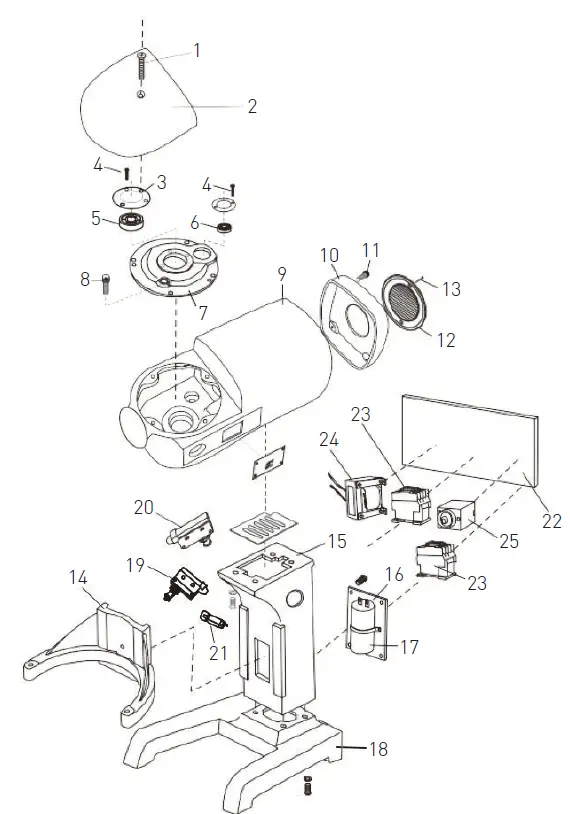
| Part no. | Part name | Quantity |
| 1 | Spiral | 1 |
| 2 | Oil seal | 1 |
| 3 | Bearing | 2 |
| 4 | Key 4×22 | 1 |
| 5 | Axle | 1 |
| 6 | Switch | 1 |
| 7 | Plastic switch plate | 1 |
| 8 | Screws M4x8 | 2 |
| 9 | Screws M6x16 | 4 |
| 10 | Bearing cover | 1 |
| 11 | Fan | 1 |
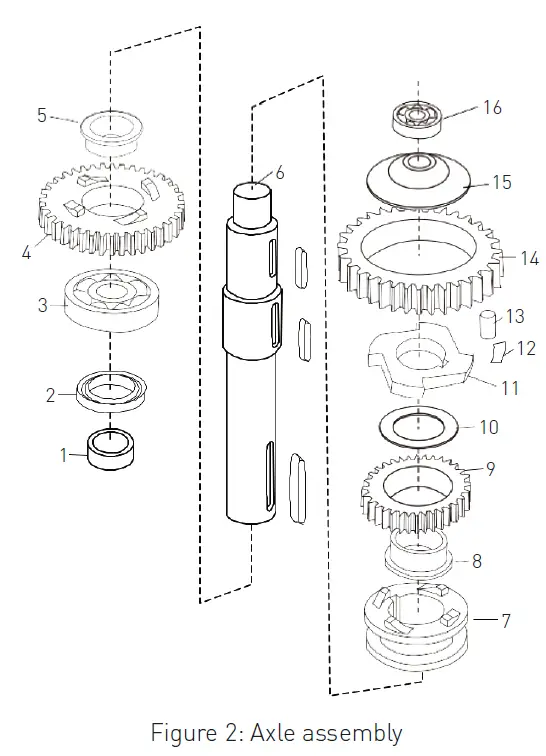

| Part no. | Part name | Quantity |
| 1 | Lifting bar | 1 |
| 2 | Cotter pin 3×30 | 1 |
| 3 | Nut M10 | 3 |
| 4 | Flat washer | 2 |
| 5 | Spring | 1 |
| 6 | Knot cover | 1 |
| 7 | Lifting handle bracket | 1 |
| 8 | Flat washer | 1 |
| 9 | Flange cover | 1 |
| 10 | Screw M6x25 | 1 |
| 11 | Key 5×20 | 1 |
| 12 | Bowl lift handle | 1 |
| 13 | Screw washer | 1 |

| Part no. | Part name | Quantity |
| 1 | Mixing axle | 1 |
| 2 | Oil seal 20x40x10 | 1 |
| 3 | Bearing | 1 |
| 4 | Bowl guard | 1 |
| 5 | Planetary gear | 1 |
| 6 | Turning plate | 1 |
| 7 | Inner gear | 1 |
| 8 | Cover | 1 |
| 9 | Bearing | 1 |
| 10 | Screw M8x20 | 1 |
| 11 | Spring washer | 1 |
| 12 | Back cover of bowl guard | 1 |
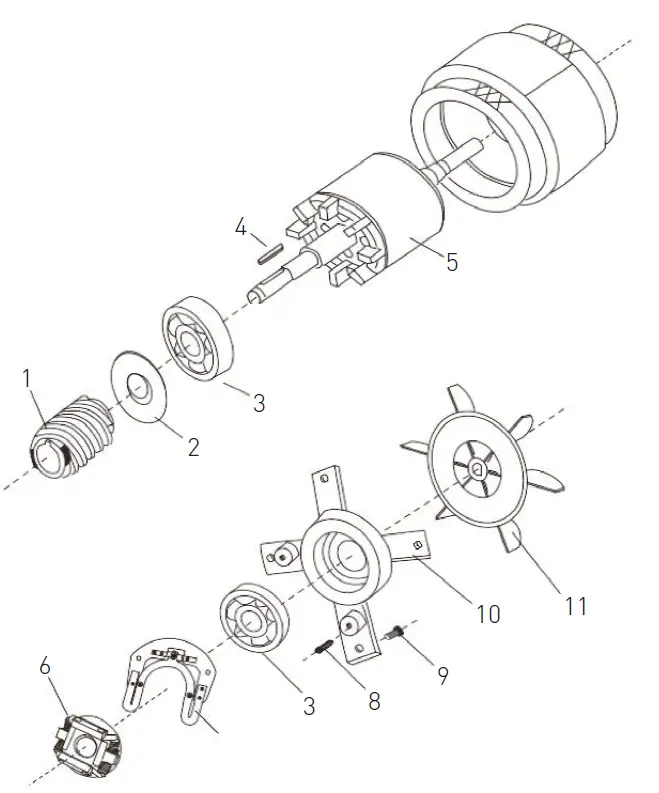
| Part no. | Part name | Quantity | |
| A | 1 | Rod | 1 |
| 2 | Nut | 1 | |
| 3 | Spring | 1 | |
| 4 | Shaft | 1 | |
| 5 | Fork | 1 | |
| B | 6 | Pin 3×20 | 1 |
| 7 | Knot | 1 | |
| 8 | Steel ball bearing | 3 | |
| 9 | Spring | 3 | |
| 10 | Block cover | 1 | |
| 11 | Screw M5x10 | 1 | |
| 12 | Shaft | 1 | |
| 13 | Lever | 1 | |
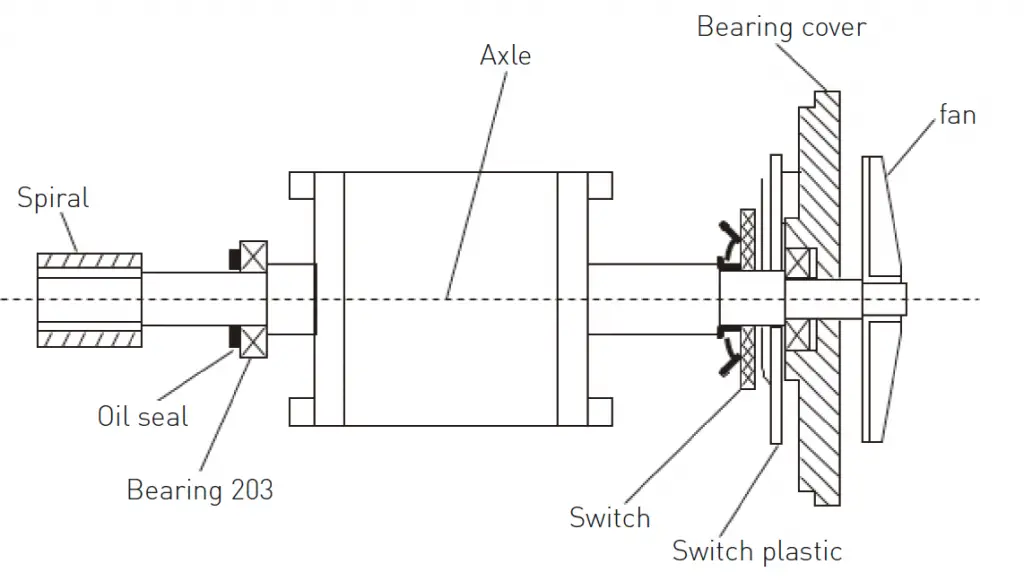
Circuit diagram
Warranty
Any defect affecting the functionality of the appliance which becomes apparent within one year after purchase will be repaired by free repair or re-placement provided the appliance has been used and maintained in accordance with the instructions and has not been abused or misused in any way. Your statutory rights are not affected. If the appliance is claimed under warranty, state where and when it was purchased and include proof of purchase (e.g. receipt).
In line with our policy of continuous product development we reserve the right to change the product, packaging and documentation specifications with-out notice.
Discarding & Environment
When decommissioning the appliance, the product must not be disposed of with other household waste. Instead, it is your responsibility to dispose to your waste equipment by handing it over to a designated collection point. Failure to follow this rule may be penalized in accordance with applicable regulations on waste disposal. The separate col-lection and recycling of your waste equipment at the time of disposal will help conserve natural resources and ensure that it is recycled in a manner that protects human health and the environment. For more information about where you can drop off your waste for recycling, please contact your local waste collection company. The manufacturers and importers do not take responsibility for recycling, treatment and ecological disposal, either directly or through a public system.
Important notice to UK users
This appliance is fitted with a UK approved mains plug and a 13A fuse. Should the fuse need to be re-placed, an ASTA or BSI approved BS1362 fuse, rated at 13A must be used. The plug can be replaced by qualified electrician if it is damaged, and ensure that the fuse is removed beforehand. Always dis-pose of defunct plugs and fuses immediately.
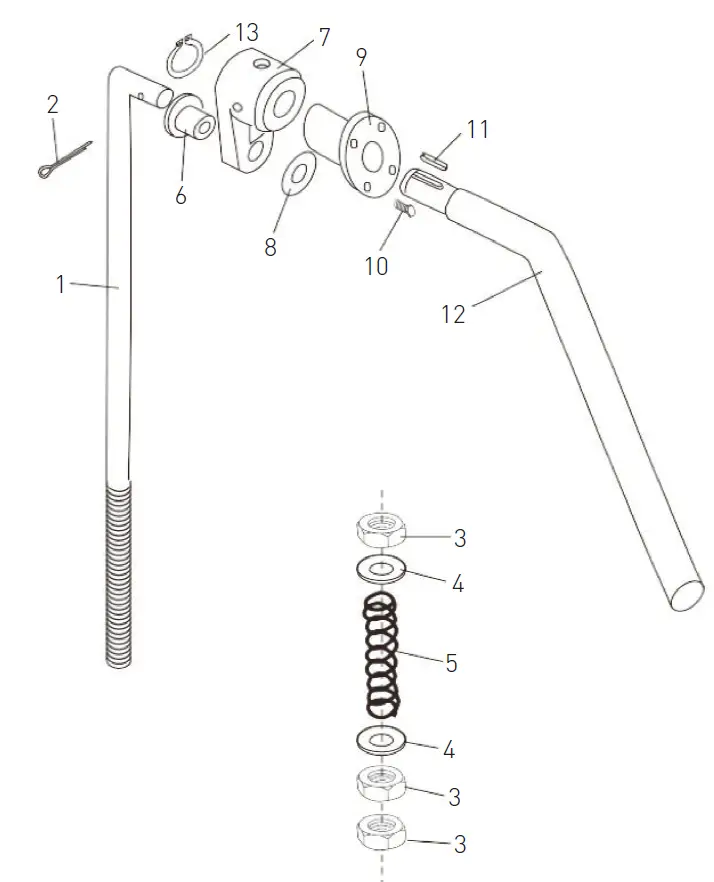
HENDI 231852 Vegetable Cutter

You should read this user manual carefully before using the appliance.
Dear Customer,
Thank you for purchasing this Hendi appliance. Before using the appliance for the first time, please read this manual carefully, paying particular attention to the safety regulations outlined below.
Safety regulations
- This appliance is not intended for household use.
- The appliance must only be used for the purpose for which it was intended and designed. The manufacturer is not liable for any damage caused by incorrect operation and improper use.
- Keep the appliance and electrical plug away from water and any other liquids. In the event that the appliance should fall into water, immediately remove plug from the socket and do not use until the appliance has been checked by a certified technician. Failure to follow these instructions could cause a risk to lives.
- Never attempt to open the casing of the appliance yourself.
- Do not insert any objects in the casing of the appliance.
- Do not touch the plug with wet or damp hands.
- Danger of electric shock! Do not attempt to repair the appliance yourself. In case of malfunctions, repairs are to be conducted by qualified personnel only.
- Never use a damaged appliance! Disconnect the appliance from the electrical outlet and contact the retailer if it is damaged.
- Warning! Do not immerse the electrical parts of the appliance in water or other liquids. Never hold the appliance under running water.
- Regularly check the power plug and cord for any damage. If the power plug or power cord is damaged, it must be replaced by a service agent or similarly qualified persons in order to avoid danger or injury.
- Make sure the cord does not come in contact with sharp or hot objects and keep it away from open fire. To pull the plug out of the socket, always pull on the plug and not on the cord.
- Ensure that the cord (or extension cord) is positioned so that it will not cause a trip hazard.
- Always keep an eye on the appliance when in use.
- Warning! As long as the plug is in the socket the appliance is connected to the power source.
- Turn off the appliance before pulling the plug out of the socket.
- Never carry the appliance by the cord.
- Do not use any extra devices that are not supplied along with the appliance.
- Only connect the appliance to an electrical outlet with the voltage and frequency mentioned on the appliance label.
- Connect the power plug to an easily accessible electrical outlet so that in case of emergency the appliance can be unplugged immediately. To completely switch off the appliance pull the power plug out of the electrical outlet.
- Always turn the appliance off before disconnecting the plug.
- Never use accessories other than those recommended by the manufacturer. Failure to do so could pose a safety risk to the user and could damage the appliance. Only use original parts and accessories.
- This appliance is not intended for use by persons (including children) with reduced physical, sensory or mental capabilities, or lack of experience and knowledge.
- This appliance must not be used by children under any circumstances.
- Keep the appliance and its cord out of reach of children.
- Always disconnect the appliance from the mains if it is left unattended or is not in use, and before assembly, disassembly or cleaning.
- Never leave the appliance unattended during use.
Special Safety Regulations
- This appliance is intended only for cutting, slicing & grating fresh vegetables (e.g. carrots, potatoes, cabbage, etc) with the use of appropriate cutting discs in commercial use. Any other use may lead to damage of the appliance or personal injury.
- This appliance should not be used for cutting frozen vegetables, bone-in meat or fish, etc.
- Use the appliance only as described in this manual.
- This appliance should be operated and installed by specialized trained personnel in the kitchen of the food industry such as catering, restaurant, bar, etc.
- All installation, maintenance and repair works should be performed by specialized trained authorized technicians.
- Do not place the appliance on a heating object. (gasoline, electric, charcoal cooker, etc.) Keep the appliance away from any hot surfaces and open flames. Always operate the appliance on a level, stable, clean, heat-resistant and dry surface.
- Do not use the appliance near explosive or flammable materials, credit cards, magnetic discs or radios.
- This appliance is not intended to be operated by means of an external timer or separate remote-control system.
- Never bypass any safety interlocks on the appliance.
- WARNING: Keep all ventilation openings in the appliance clear of obstruction.
- WARNING: ALWAYS switch OFF the appliance and unplug from electrical power supply before cleaning, maintenance or storage.
- WARNING: ALWAYS keep hands, long hair and clothing away from the moving parts.
- Allow at least 20 cm spacing around the appliance for ventilation purpose during use.
- Caution! Securely route the power cord if necessary in order to prevent unintentional pulling or contact with the heating surface.
- Do not wash the appliance with water or waterjet. Washing with water can cause leakage and increase the risk of electric shock. No parts are dishwasher safe.
- Do not clean or store the appliance unless it is completely cooled down.
- Do not move the appliance while it is under operation. Unplug the appliance when moving and hold it at the bottom.
- Do not operate the appliance without vegetables to avoid overheated.
- WARNING! Take great care when handling the cutting discs. Wear protective gloves (not supplied) if necessary.
Intended use
- The appliance is intended for professional use and can be operated only by qualified personnel.
- The appliance is designed only for cutting, slicing & grating fresh vegetables (e.g. carrots, potatoes, cabbage, etc) with the use of appropriate cutting discs in commercial use. Anyother use may lead to damage of the appliance or personal injury.
- Operating the appliance for any other purpose shall be deemed a misuse of the device. The user shall be solely liable for improper use of the device.
Grounding installation
This appliance is classified as protection class I appliance and must be connected to a protective ground. Grounding reduces the risk of electric shock by providing an escape wire for the electric current. This appliance is equipped with a cord having a grounding wire with a grounding plug. The plug must be plugged into an outlet that is properly installed and grounded.
GENERAL
DESCRIPTION
The multi-purpose vegetable cutter can slice, shred, grate, chip and dice various foodstuffs (for the preparation of raw and cooked vegetables, fruit). With its range of cutting discs, the device is ideal for restaurants, high occupancy kitchens, institu-tions and small companies.
GENERAL PRECAUTIONS
- The vegetable cutter must be operated only by qualified personnel familiar with the use and safety instructions included in this manual.
- In case of personnel rotation, vocational training is necessary.
- Although the device is equipped with several safety systems, avoid touching the cutting discs and moving parts.
- Before any cleaning and maintenance operations check if the device is disconnected from the mains.
- Periodically check the cables and electrical elements.
- Do not use the device to cut frozen food. Remove all hard parts from foodstuffs before cutting to avoid damage of the cutting blades.
- Never replace any parts of the device by yourself. Call the authorized service.
TECHNICAL DATA
SPECIFICATION SHEET
Item no.: 231852
Operating voltage & frequency: 230V ~/50Hz
Rated input power: 750W
RPM Disc: 300 RPM
Noise level: < 60 dB
Protection class: Class I
Waterproof protection class: IP23
Dimensions: 500X250X(H)470 mm
Remark: Technical specification is subjected to change without prior notification.
DELIVERY CONDITIONS AND PACKING DISPOSAL
The vegetable cutter is packed in a sturdy card-board box with shaped internal edges, which guar-antees perfect integrity of the machine during transport.
Each device includes:
- Operations and maintenance manual.
- Ejecting disc.
- All packing components (cardboard box, foam, straps etc.) Can easily be disposed of as municipal waste.
INSTALLATION
SETTING THE DEVICE
The device connection and setting must be per-formed by qualified personnel.
WARNING: both the system and location where the equipment is to be installed must comply with the occupational safety and health regulations as well as other regulations in force.
ELECTRIC CONNECTIONS
The device is supplied with an electrical cable to be connected to a thermal magnetic switch switching off the device in case of accidental contact of the The manufacturer and the seller shall not be held liable for any the manufacturer and the seller shall not be held liable for any regulations. Place the device on a wide, levelled, dry and stable surface, away from heat sources and water jets.
operator with moving parts.
The device must be grounded according to the local regulations in force.
The manufacturer and the seller shall not be held liable for any direct or indirect damage which may result from failure to observe the local regulations n force.
The vegetable cutter is manufactured to be used with 230V ~50Hz single-phase connection. If the voltage is different from the data specified
on a rating plate, please contact the seller.
SINGLE-PHASE CONNECTION
SAFETY MEASURES AND END USER TRAINING
Skilled personnel in charge of the installation and electrical connections of the device shall be responsible for training end users. Safety measures to be applied should be communicated to end users. This operation manual is supplied together with each device.
DEVICE OPERATION
CONTROLS
The controls and pilot light are located on the top of the device in the middle of the alumilium base.
- Green (I) start push button
- Red (O) stop push button
ASSEMBLING THE DISCS
Lift up the locking handle as shown in figure no. 1 And open the cover. Remove the ejector and place appropriate disc. Close the cover. Push the start button to automatically hook the discs in the correct position.

DISCS – STANDARD EQUIPMENT
| PICTURE | PART NO. | SIZE | |
| Shredding discs | 280300 | 3mm | |
| 280416 | 5mm | ||
| 280317 | 7mm | ||
| Slicing discs | 280102 | 2mm (3 blades) | |
| 280126 | 4mm (2 blades) |
USING THE DISCS
The device is supplied with the ejector fitted to the drive spindle. Release the cover lock and lift the cover to remove the ejector (see figure. 1)
Before starting work always check the cleanliness of the cutting chamber, the drive spindle, the ejector and the cutting discs.
- Slicing, shredding and grating
- Mount the ejector onto the flat surface of the drive spindle.
- Mount the required disc (slicing, shredding or other – options.
- Turn the dics clockwise to insert the bayonet and keep on turning closwise until it reaches the pin.
- To remove the disc, turn it in the opposite direction and lift it using the finger holes at the edges of the disc.
- Close and lock the cover.
- Cutting into chips or cubes (option)
- Mount the ejector.
- Mount the chips/dice disc in the housing and check for correct fixing (the assembly area must be clean). The upper edge of the chips/dice disc must be placed slightly below the top of the body of the device.
- Then mount the slicing disc of the same size as the chips/dice disc and close the cover.
CLEANING AND MAINTENANCE OPERATIONS
GENERAL INFORMATION AND PRODUCTS USED FOR CLEANING
Before carrying out any cleaning or maintenance operations, check if the mains switch is off and the plug is disconnected from the mains.
Clean the device and the discs thoroughly every day to ensure correct operation and long life of the device.
The cutting discs and the ejector can be cleaned with a warm water jet.
Clean the device, in particular the disc assembly, only with a cloth or a sponge damped in warm water. Thoroughly remove all remaining foodstuff to prevent the discs from changing their position. Open the cover and loosen pin 1 as shown in figure no.3. Remove the cover and wash with warm running water.
Clean the surfaces with water with soap, alcohol, non-abrasive detergents or with water without chlorine- or soda-based substances (chlorinated water, hydrochloric acid).
IN CASE OF FAILURE
When the white pilot light on the panel is on and the device does not start, check if the handle and the cover are closed. Safety microswitches are activated this way. The safety microswitches prevent the Never use abrasives, steel wool or similar products as they may damage the surface, coating or body of the device.
For cleaning use non-toxic hygiene products.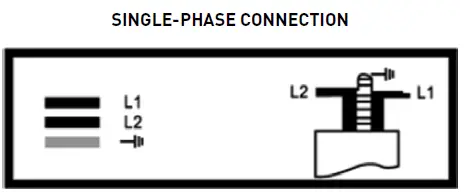
machine start if the securities are not activated. In case of failure, unplug the device and call the maintenance service or qualified personnel.
Do not start the device or attempt self-repairs.
DEVICE IDLE FOR A LONG TIME
If the vegetable cutter is to be idle for a long time, unplug and thoroughly clean the device and accessories. Use white Vaseline oil (or any similar product) to protect all parts of the device.
These products, mainly composed of oily substances and detergents, and available in spray cylinders for easy application, make aluminum surfaces glossy and prevent moisture and corrosion.
We recommend covering the device with a nylon (or similar) cloth.
ELECTRIC CIRCUIT
VEGETABLE CUTTER – SPARE PARTS LIST
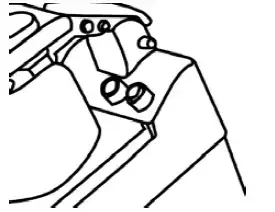
| No. | Part Name | No. | Part Name | No. | Part Name |
| 1 | Handlebar arm | 28 | Pin | 55 | Bolt |
| 2 | Screw | 29 | Screw | 56 | Front cover of motor |
| 3 | Handlebar arm | 30 | Stator | 57 | Square key |
| 4 | Gasket | 31 | Rotor | 58 | Bearing cover |
| 5 | Gasket | 32 | Motor shaft | 59 | Oil seal |
| 6 | Gasket bolt | 33 | Spring gasket | 60 | Bearing cover |
| 7 | Pusher cap | 34 | Bearing | 61 | Shalf sleeve |
| 8 | Pusher | 35 | Ripple gasket | 62 | Screw |
| 9 | Small feeder hopper | 36 | Motor back cover | 63 | Nut |
| 10 | Hopper | 37 | Fan | 64 | Bearing |
| 11 | Seat of magnet | 38 | Spring gasket | 65 | Bolt |
| 12 | Magnet steel | 39 | Ejector | 66 | Strapped wheel |
| 13 | Screw | 40 | Core of disc | 67 | Belt |
| 14 | G003 grater disc | 41 | Ejector device | 68 | Belt wheel |
| 15 | Disc | 42 | Output axis | 69 | Nut |
| 16 | Spring | 43 | On switch | 70 | Contactor |
| 17 | Hook | 44 | Off switch | 71 | Support of contactor |
| 18 | Pin | 45 | Pin sleeve | 72 | Screw |
| 19 | Locking handle | 46 | Flat washer | 73 | Support of electric box |
| 20 | Flat washer | 47 | Fixing flat | 74 | Electric box |
| 21 | Spring washer | 48 | Screw | 75 | Bottom base |
| 22 | Screw | 49 | Microswitch-a | 76 | Clamp |
| 23 | Hopper lid spindle | 50 | Microswitch-b | 77 | Capacitor |
| 24 | Gasket | 51 | Flat washer | 78 | Bottom plate |
| 25 | Power cord | 52 | Screw | 79 | Foot |
| 26 | Body | 53 | Support of motor | ||
| 27 | Seat of magnet | 54 | Screw | ||
Warranty
Any defect affecting the functionality of the appliance which becomes apparent within one year after purchase will be repaired by free repair or re-placement provided the appliance has been used and maintained in accordance with the instructions and has not been abused or misused in any way. Your statutory rights are not affected. If the appliance is claimed under warranty, state where and when it was purchased and include proof of pur-chase (e.g. receipt).
In line with our policy of continuous product development we reserve the right to change the product, packaging and documentation specifications with-out notice.
Discarding & Environment
When decommissioning the appliance, the product must not be disposed of with other household waste. Instead, it is your responsibility to dispose to your waste equipment by handing it over to a designated collection point. Failure to follow this rule may be penalized in accordance with applicable regulations on waste disposal. The separate col-lection and recycling of your waste equipment at the time of disposal will help conserve natural resources and ensure that it is recycled in a manner that protects human health and the environment. For more information about where you can drop off your waste for recycling, please contact your local waste collection company. The manufacturers and importers do not take responsibility for recycling, treatment and ecological disposal, either directly or through a public system.
